RATGATE ---- the saga of dead rats, birds & fish on the
NORTH BEACH, WESTPORT, South Island NZ
as at 30th Dec 2019
CAROL SAWYER·FRIDAY, DECEMBER 6, 2019·6 M
INUTES
TIMELINE :
1 - 3 November, 2019 - The Dept of Conservation aerially drops 104 tonnes of 1080 poison baits into the Maruia River catchment, South Island, to kill rats. This catchment feeds into the Buller River which eventually flows out to sea at Westport, 140 kms downstream.
********************************
8 November -- A Westport local spots numerous dead creatures (rats, birds, marine life and a goat) on North Beach, Westport, at the mouth of the Buller River, after heavy rain.
********************************
9 November - Locals collect a trailer-load of 680 dead rats, a goat, octopods, skates, sole, starfish, crabs, barracuda, monkfish, crayfish ( all bottom feeders which could have eaten 1080 baits washed to sea) and dead seabirds from North Beach and local Trevor Reid goes to the DoC office at 1.30 pm to ask for assistance.
Trevor is then made to wait for an hour in the carpark while, as we later find out via OIA request, DoC’s West Coast Operations Director, Mark Davies, frantically downloads photos of the dead creatures from anti-1080 Facebook pages and starts a flurry of emails to DoC’s Deputy Director General, Mike Slater, Director of National Ops, Hilary Aikman, and the CEO’s of Buller and West Coast Regional Councils, Sharon Mason and Michael Meehan, among others. By 2.50pm Mark Davies has already drafted a media release ! DoC names this cover-up operation “Operation Tidy Rat”.
Two DoC workers eventually come down to North Beach with a digger and dig a two metre deep hole in the sand and bury the potentially toxic load on the beach. Freedom campers move elsewhere.
Buller District Council, on behalf of DoC, announces that the aerial 1080 drop at Springs Junction the previous week (Maruia catchment) "may have contributed to the problem", and advises caution. As these carcasses could have been victims of both primary and secondary 1080 poisoning, selected carcasses are sent for testing - both by DoC and by an independent group.
*******************************
11 November - DoC, now moving into damage control, changes its story. On Prime TV News, West Coast Operations Director Mark Davies says 'Doc thinks it's unlikely the rats were poisoned by 1080 in a recent drop, then washed out of the hills by heavy rain. "I just can't imagine that the two are connected", he said.'
To Newshub, Davies said "... reports of dead fish and birds - along with the rats - are not consistent with the way 1080 is understood to work." ( This statement is illogical considering 1080 poison is indiscriminate.)
However 'One News' hadn't quite caught up with the new fairy story and said "The Department of Conservation (DOC) said they may be victims of a recent 1080 drop 140 kilometres away in the Lewis Pass National Reserve."
Also on 11 November, more dead rats and dead muttonbirds are discovered on a beach 8 kms north of Westport, seagulls are seen picking dead rats out of the sea at Waimangaroa Beach 17 kms north of Westport, and further reports come in of dead creatures found at Punakaiki and elsewhere..
*******************************
12 November - "DOC's West Coast regional director of operations Mark Davies said the 1080 theory was however just that - a theory - and highly unlikely." TVNZ News
*******************************
13 November - DoC's Buller Operations Manager, Bob Dickson, clutching at straws now, announces a brand new DoC theory - The rats were committing suicide. They had run out of food and were all jumping into the rivers and rafting, dead, down to the beaches.
*******************************
15 November - Announcement by two non-profit environmental groups, Flora and Fauna Aotearoa and Clean Green New Zealand that the first independent laboratory test results have been returned. Laboratory scientists tested samples taken from 5 rats, 1 Weka, 2 Sooty shearwaters, 1 starfish and 6 mussels. The samples from 4 of the 5 rats tested positive for three chemical markers of 1080 poison, including the toxic chemical, fluorocitrate. This was also the case for the birds. The starfish and weka also tested positive for fluorocitrate. There were no traces of 1080 detected in the mussels.
Very significantly, three of the rats and the two Sooty shearwaters also tested positive for the presence of green dye acid 9, which is only used in the bait pellets and is not a naturally occurring substance at detectable limits.
There were physical signs of poisoning in some of the animals as well.
The laboratory scientists’ professional conclusion is that the deaths of the beach animals tested were almost certainly caused by 1080 poison.
***********************************
20 November - The Dept of Conservation finally announced the results of ITS testing of samples taken from North Beach, Westport. They said that Landcare Research had tested eight dead rats and one Weka, none of which had any residue of 1080 toxin. Landcare did not test for anything other than fluoroacetate. They said “We were not asked ( by DoC) to test for other chemicals." Fluoroacetate metabolises into fluorocitrate after being ingested. Landcare should have tested for this substance. In view of this fact, Prof. Ian Shaw, expert toxicologist at the University of Canterbury, said he found this “confusing”. Landcare told a journalist “Fluorocitrate remains in complex with the aconitase enzyme. It is therefore difficult to test for.” Yet the independent laboratory was able to test for fluorocitrate and found it in all animals tested except the mussels.
DoC once more declared that the influx of dead rats on North Beach was a result of their being starving (despite a megamast in the beech forest, and a hundred tonnes of 1080 cereal baits landing on them) and swimming across rivers in desperation in search of food, thereby drowning, and that the dead marine creatures were a result of stormy weather.
************************************
19 December - ‘Independent testing’ scientist named as Dr. Nick Wall and the testing laboratory named as his Ideas Lab, Timaru. Dr. Wall is a highly-qualified UK scientist (BSc Hons, MSc, two PhD's in surface chemistry, and an MBA). His laboratories worldwide are contracted by many of the world's largest organisations to solve thorny problems for them, and have a strong and long list of successes. His laboratory budget globally is greater than Landcare's and DoC's combined, and he employs more independent scientists than either of them.
*************************************************
FOOTNOTE:
The Dept of Conservation, hoping that time will erase this business from people’s memories and that 'Operation Tidy Rat', as they called it, will have tidied itself away to nothing, have conveniently forgotten that nearly 1,000 highly toxic carcasses are buried a few feet down in an unmarked grave in the sand on North Beach, Westport. We have not !
With regard to Ratgate, these are some of the questions that remain:
Why is Landcare using a testing method more than 30 years old?
Why was a crayfish collected and not analysed?
How long did Massey University hold onto the samples for autopsies (which were inconclusive) before sending the remains to Landcare?
Is there a chain of custody for what was tested?
Which parts were sent from Massey to Landcare, and which parts did Landcare analyse?
Were the samples homogenized to release any bound fluoroacetate?
Why did Landcare not release all the results?
MOST IMPORTANTLY, as at 29 December 2019 , Dr. Wall has eight highly regarded teams getting up to speed on this topic internationally, as there are still many questions remaining to be answered, and these teams intend to provide answers to a global audience--to be continued
|
DECEMBER 16TH 2019 NORTHLAND 1080 DROP GONE WRONG
3 DOGS AND 2 COWS DIED AFTER EATING FROM A 1080 DROP.
A Labrador and German Shepherd died after eating the carcass of a possum in a paddock in the Hukerenui Community Pest Control Area. Then another dog is believed to have died after eating material vomited up by the first two dogs. They seem to blame the fences for the 2 heifers to stry and die??? this is NZ Dec 2019 |

CHECK THE LATEST 2019 POISON DROPS IN
THE SOUTH ISLAND OF NZ
NZ CLEAN GREEN COUNTRY WITH WATERWAYS CONTAMINATED & LAKES A DISASTER.
Government, Maori & Kiwi's need to do more to
save our heritage
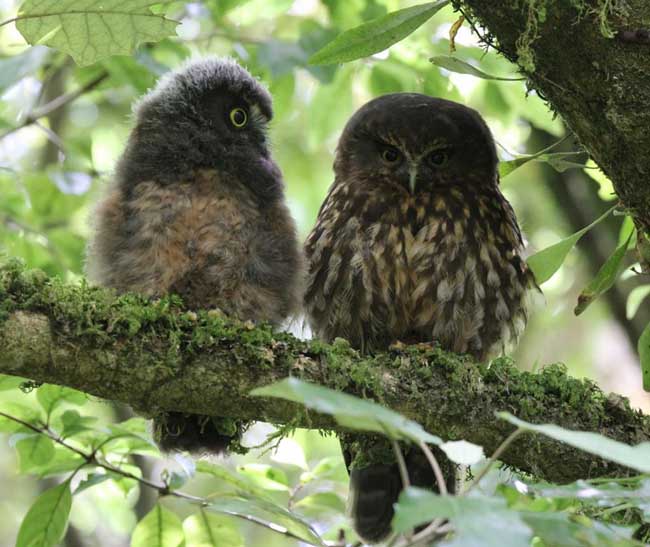
Morepork, endemic to New Zealand. Maori name - Ruru ( Ninox novaeseelandiae ).
Adult and juvenile.
Photo NZ birdsonline
Check this video below from USA how true the situation
is in NZ. Just think if we had an economy crash--
could we eat & survive from the bush wildlife???
Check the above video........
1080 poison tests in New Zealand are based
on methods written in 1987 – 32 years ago.
Flashback: You may remember 1987 as the first year the Rugby World Cup was held, which of course the All Blacks won against France. We were listening to ‘Funky Town’ by Pseudo Echo on our radios.
In 1987 the first mobile phone became widely available - it was a brick.
The Internet was still in a very early stage of development (there was no HTML yet). Only a handful of .com websites existed. New home computers were large, heavy, expensive machines. The IBM PC-RT had only 1 MB of RAM, a 1.2-megabyte floppy disk drive, and a 40 MB hard drive. That old computing power has increased beyond any expectations, for example in 1987, a typical computer was processing 25 MIPS (millions of instructions per second) - compared to today's computers which are working at 304,510 MIPS…
Worldwide, over those 32 years, chemical pesticide analysis has been making full use of those amazing technological advances and continuously improving through the sharing of international expert knowledge.
But not in New Zealand.
Despite NZ authorities using more harmful pesticides than any other OECD country, our Governments have repeatedly ‘stopped the clock’. 1080 poison testing is only conducted in Government labs and those tests are using methods that were appropriate in 1987, but are now dangerously flawed. That's because these old tests are NOT picking-up traces of chemicals that are toxic to us and our environment. FB: Dec17th 2019
|
Sodium Monofluoroacetate (1080)
Originally patented in 1927 as an insecticide, 1080 was not recommended for commercial use due to its high toxicity and persistence. 1080 interrupts the metabolic process of any life form that requires oxygen; it is the nearest thing there is to a universal poison. There is no known antidote to a lethal dose. The name 1080 comes from its laboratory accession number at the Patuxent Wildlife Research Centre in Maryland, USA, where it was being tested as a rat poison around 1944 [Monsanto held the patent for 1080 at that time]. Although it can kill most living things, some are more susceptible than others, eg fish or freshwater crayfish can consume without obvious effect [in the short term] amounts that would kill other creatures.
The United States was the first country to use 1080 in pest destruction programmes, initially against rats, coyotes and squirrels. Later it was used to control gophers and harvester ants. Its use is now banned in that country except for specific situations where permits are issued for very restricted applications [sacrificial collars on sheep or goats against predators]. 1080's use is totally banned in the State of California.
In New Zealand it is the poison of choice for just about all pest control work, from possums and wasps to rats. It is also claimed that through secondary poisoning it can "target" stoats. This small country spread by aircraft around 90% of the total world production of 1080, enough [at the time of writing] to kill around 20 million people per annum, on its lands, forests and waters.
The mode of action of 1080 (sodium monofluoroacetate) is for the fluoroacetate component to attach to citric acid, converting it to fluorocitrate. By complex processes, the citric acid that is vital to the generation of energy in cells, is now converted to a compound that stop the enzyme that bodily cells require as part of their metabolic processes. It cannot be undone, and so there is no antidote. It kills the cells of any air breathing creature—insect, bird or [other] animal. Ian Shaw, Professor of Toxicology at Canterbury University puts it quite bluntly:
"So if anyone tells you that 1080 can discriminate between pests and native animals they are talking complete and utter rubbish."
There is a wide variation in susceptibility to 1080. The lower tested LD50 [the lethal dose that may kill 50% of a species] is 0.05mg per kg body weight for the Texan Pocket Gopher, and the highest, 500mg per kg for the South African Clawed Toad. In New Zealand, dogs are the most [known] susceptible species with an LD50 of 0.07mg per kg of body weight. The LD50 for the possum is 1.2mg/kg [Eason, 2010], and for the mouse a whopping 13mg/kg. The LD50 for people is between 0.5-2mg/kg [no trials have been done for obvious reasons], so for an average 70kg person, about 35-140mg is a potential LD50 dose. It is a potent material; what's more, there is no known antidote.
1080 can get into the human food chain as was shown by a 2014 study by the Cawthron Institute on trout eating poisoned mice. Although a lethal dose is highly unlikely, a sub-lethal well in excess of minimum food safety standards can occur from trout eating poisoned, but still living, rats, mice and freshwater crayfish. Eels scavenging poisoned carcasses in the water could also carry significant sub-lethal doses with risk of damage to the body organs and genetic consequences to the victims. The actual risk is unknown; as the country that uses most of the poison, New Zealand, will not carry out any studies as to the risk. Commercially caught and processed eels exposed to the poison are not tested for the presence of the poison and are known to be exported from New Zealand—a country that has branded itself as "clean and green".
At War With Nature
Corporate Conservation and the Industry of Extinction
Chapter 9. The Perfect Solution
Pages 107-108
By WF Benfield
Available:
https://trosspublishing.co.nz/publication/at-war-with-nature
Official Information Act requests can be very valuable -
when you know what to ask for specifically.
In the case of the proposed aerial 1080 poison operation over Pirongia Mountain next year, it is now revealed that crucial information trappers needed to apply for a tender for sustainable and safe 'pest' control was deliberately withheld until after the deadline. Six months earlier, DOC and Waikato Regional Council (WRC) were secretly already deep into planning the aerial poison operation on Pirongia - regardless of the fact that there was no meaningful data on the condition of foliage or monitoring of any 'pest' numbers. To these DOC and WRC staff, those reports were totally irrelevant because 1080 poison isn't about controlling 'pests' - that's just a cover story.
Other things that were discussed at those meetings were how they could get away with limiting the fake 'consultation' with the public about the poisoning operations. For instance, they decided to publish their full-page advertorial of propaganda about how 'safe' 1080 poison is (image 1) in the Te Awamutu Courier. This is a relatively small paper with a circulation of approx 14,000, compared to the main newspaper of the area, the Waikato Times, circulation approx 40,000. DOC claimed in an OIA response that this was due to 'budget restraints'. But we know the real reason.
The juggernaut of the DOC poisoning machine is well-established and well-rehearsed. It growing out of control. But it can be stopped. NZ media is increasingly aware of the fraudulent activities of DOC and now open to publishing letters that question the propaganda (Image 2). Write a short email or letter today - let's share our knowledge and get the facts out there.
12/12/2019 FB
WESTPORT South Island NZ. RAT PROBLEM BUT DEAD BIRDS & FISH LIFE

NOT DISCUSSED & the saga of testing goes on.
Another main character in the New Zealand 1080 poison aerial operations is Fenton Wilson. Previously a councillor for Hawkes Bay Regional Council, where he used delaying tactics for a new environmental protection policy. He has been a Director of Ospri for nearly 5 years. Ospri is the Government agency using aerial 1080 poison operations in an invented fight against bovine TB in possums. Ospri's shareholders are DairyNZ, Beef + Lamb New Zealand and Deer Industry New Zealand alongside the Ministry for Primary Industries.Wilson is also a Chairman Trustee of Predator Free NZ Trust, the organisation that benefits from $millions of DOC-funded 1080 poison operations that are in addition to the Ospri operations. But these roles perhaps aren’t demanding enough, because Wilson is also Director of Centralines power company and a road construction company.
We wonder how these board members have time to engage properly with multiple commitments like these, with so many conflicts of interest?
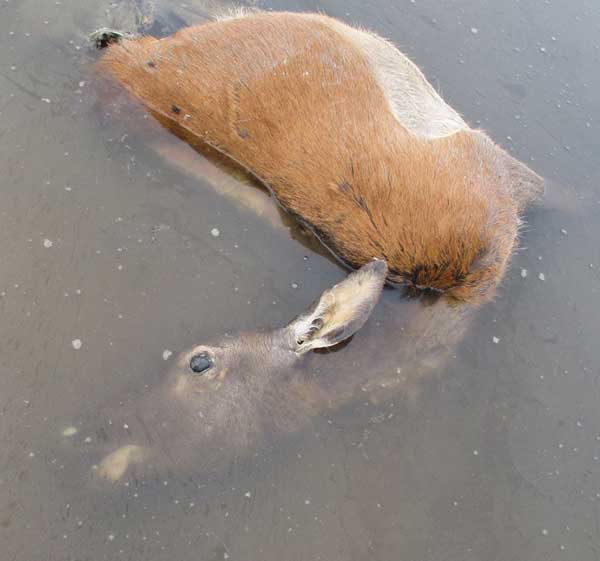
Deer poisoned ---P Lusk & this is NZ.
FB: POST There is a scheme which DOC call the RUN, where helicopters flying around identifying where the animal tracks are, once they identify the area, doc start laying feed along these tracks leading animals to an area or drop zone and then drop 1080 to make sure that they kill deer pigs and any thing else that follows the feed trail, and also affecting birds as birds will eat the grubs and drink the water of either contaminated carcasses take it back to their nest where it feeds it's young and they are also poisoned, along with the kiwi which are meat eaters, also DOC set a gel type poison on trees to a specific height to kill deer. Workers that work for DOC have to sign and agree not to say that they will not leak any of the practices that DOC use
FB: POST This was seen at Porirua a couple of years ago. The baits were dropped in lines to encourage the deer to follow the trail thus consuming more poison pellets. Deer are targeted despite the official position being that they are not. In an area of around an acre councillors saw ten dead deer beside the farm; most of them healthy stags.
8th Dec 2019 from FB:
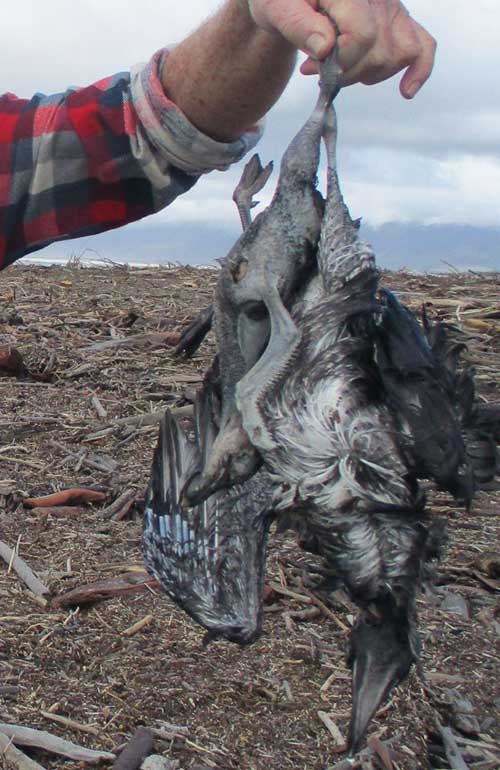
Pics: Peter Lusk
POSITIVES FROM THE WESTPORT RATS EXPERIENCE.
You wouldnt think much good could come from 700+ rats arriving suddenly on the district's most popular beach. But there are several positives for us:
1. The rats got in the main stream media along with the other dead creatures like bottom-feeding sealife, birds and 3 baby whales that were almost certainly a result of eating poisoned rats.
2. We were able to get independent testing which proved 1080 was the cause of death for a number of the creatures.
3. It got others speaking out, such as scientists and a trout fishers' organisation.
4. We achieved a new level of coordination locally. This came about because the poisoned creatures were spread along more than 100km of coast if we count the baby pilot whale that washed ashore north of Karamea and DOC got rid of without testing.
WESTPORT'S NORTH BEACH 'RATGATE'- AERIAL 1080 DROP, MARUIA - A MASSIVE 104 TONNES 1080 BAITS
Former local, Ron Eddy, has sent me the following:
"The theory the rats may have come from the Springs Junction area is possible because the Maruia River empties into the Buller below Murchison and then it is a straight run down to Westport ... my old home town! The fact they have ended up on the North Beach would be due to the rats being floating out of the mouth of the Buller and then being picked up by the strong northerly current that runs straight up the West Coast. With extended breakwaters out into the sea the rats would have then been sucked around the end of the Northern one and then been washed up on the beach.
If this is the case then that scenario is one of deep concern .... 1080 affected animals carried so far and still a viable agent for secondary poisoning? If cockroaches full of brodifacoum can kill Tuatara by secondary poisoning then 1080 laden rats could kill dogs and any other animal that ate them."
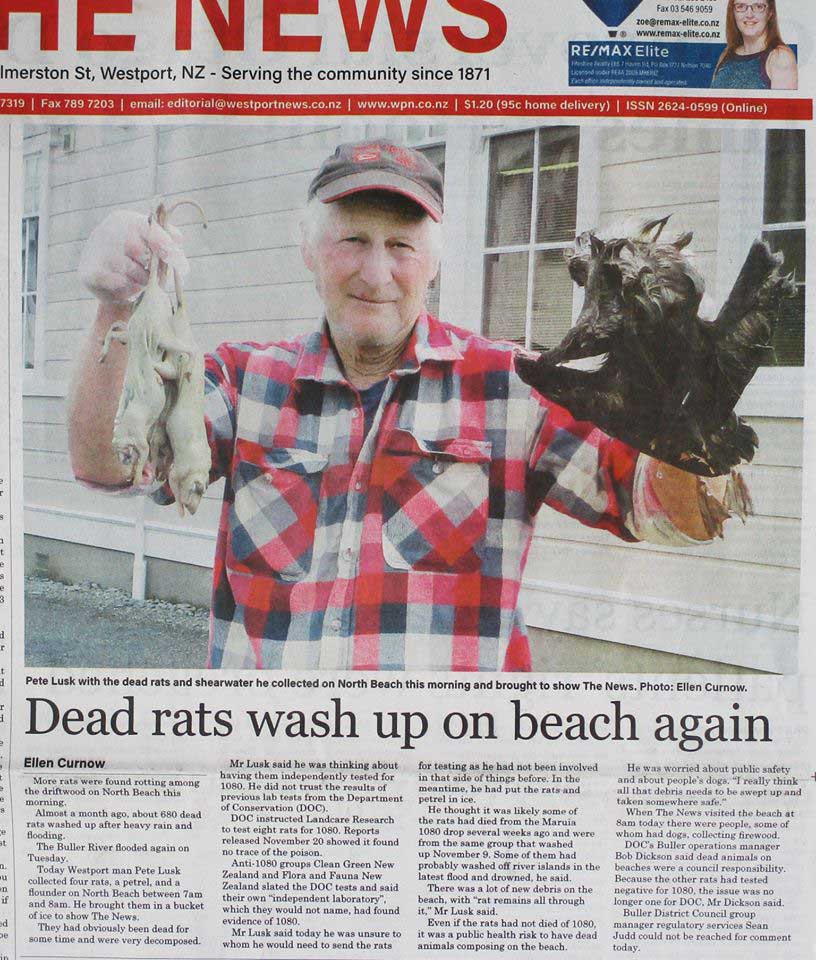
******************************************************
This aerial 1080 drop was carried out on 1 and 2 November, 2019. DoC used their new sowing method of overlapping flight paths to give a 50% greater amount of 1080 baits dropped, so that 1.5 kgs per ha became 2.25 kgs per ha. The area poisoned was, according to the map, 46,067.14ha, which equates to 103, 651 kgs x toxic 1080 baits.
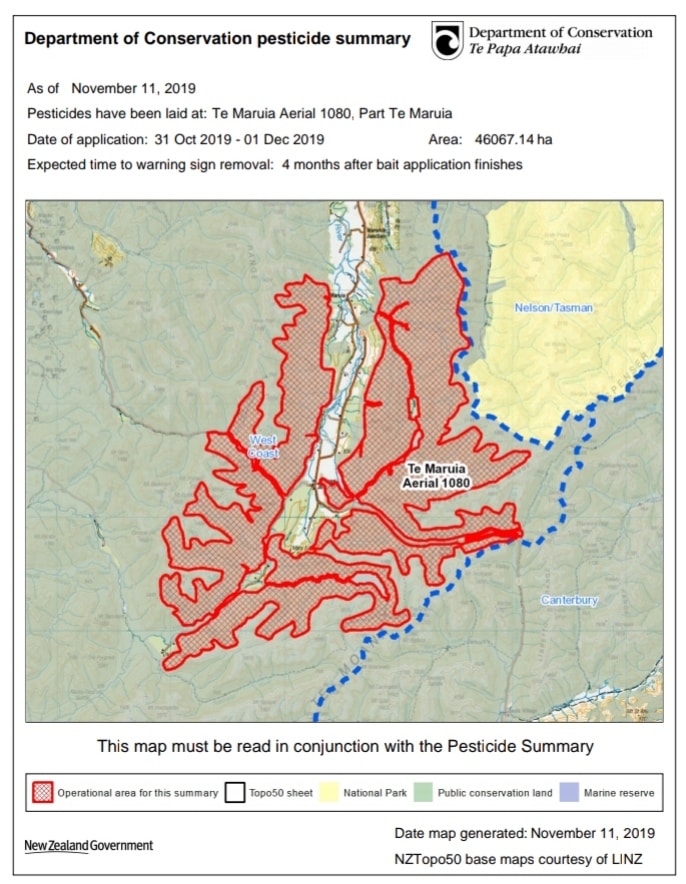
Carol Sawyer |

Note the birds and crayfish in the above
that wasn't told about??
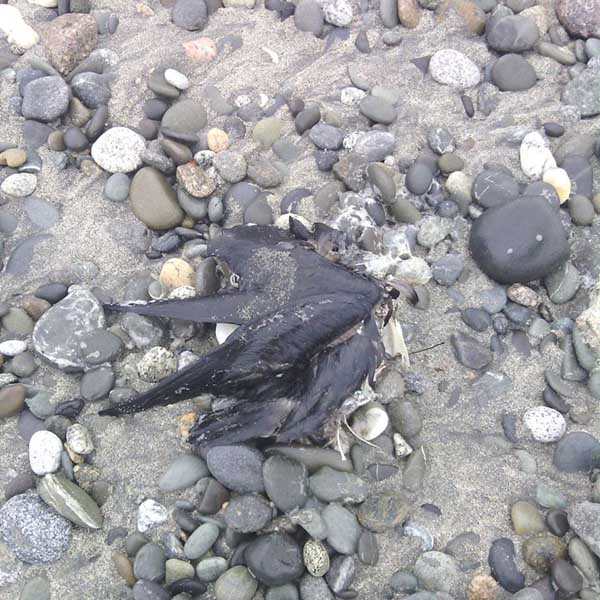
Trevor Reid
I went for a walk this morning and found rats on the beach about 8 ks north of Westport after I took the dog home went back and picked up these there are 3 titi or sooty shearwaters thats 5 I have seen so far, This is a major poisoning event ended up with half a bucket . Shame on you poisoners
NEW SCIENCE ON RAT SUICIDES??????
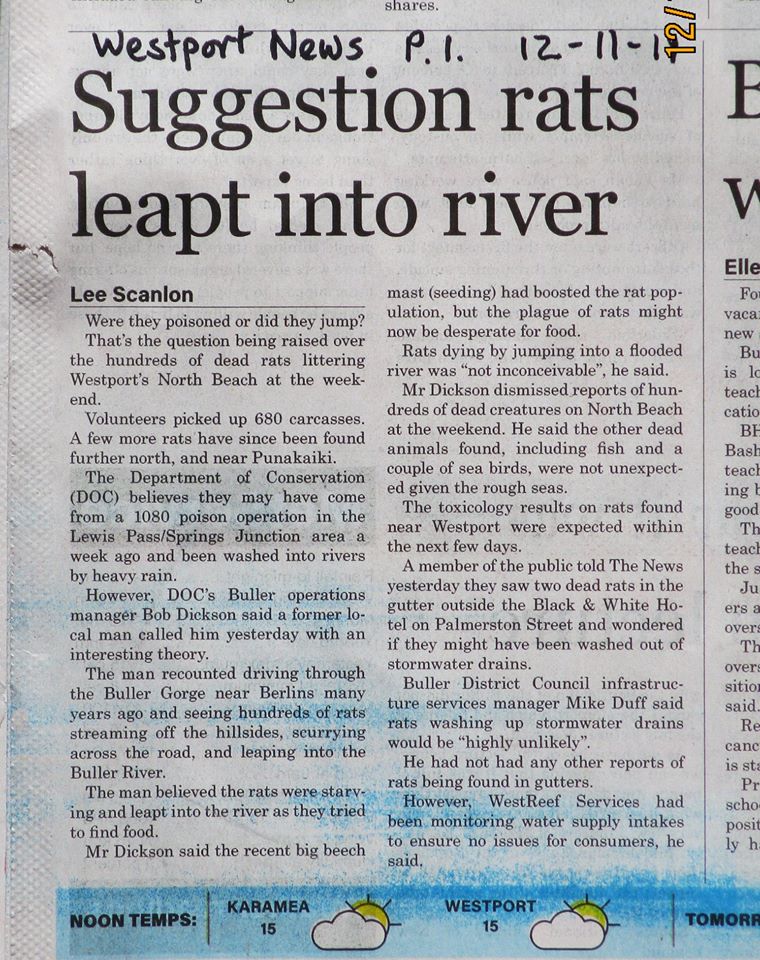
More interesting news from the Dept of Conservation:
On 1 November, DoC aerially dropped 104 tonnes of 1080 poison baits on the Maruia catchment because, they said, there is a beech mast producing masses of food, and consequently a plague of rats all over the country.
One week later, a large amount of dead rats (680) washed up on North Beach at Westport (12 November, 2019). This is quite an unusual occurrence and might be explained, according to DoC's Buller Operations Manager, Bob Dickson, by the fact that the rats were starving to death, jumping into the rivers, and ending up on the beaches.
A glut of food one week. Suicidal starvation the next. Well, that's quite a turnaround!
One has to ask the question... if the rats are voluntarily jumping into the rivers, at no expense to the taxpayer, why would DoC feel the need to drop tonnes of 1080 poison on rats that are doomed already?
Carol Sawyer
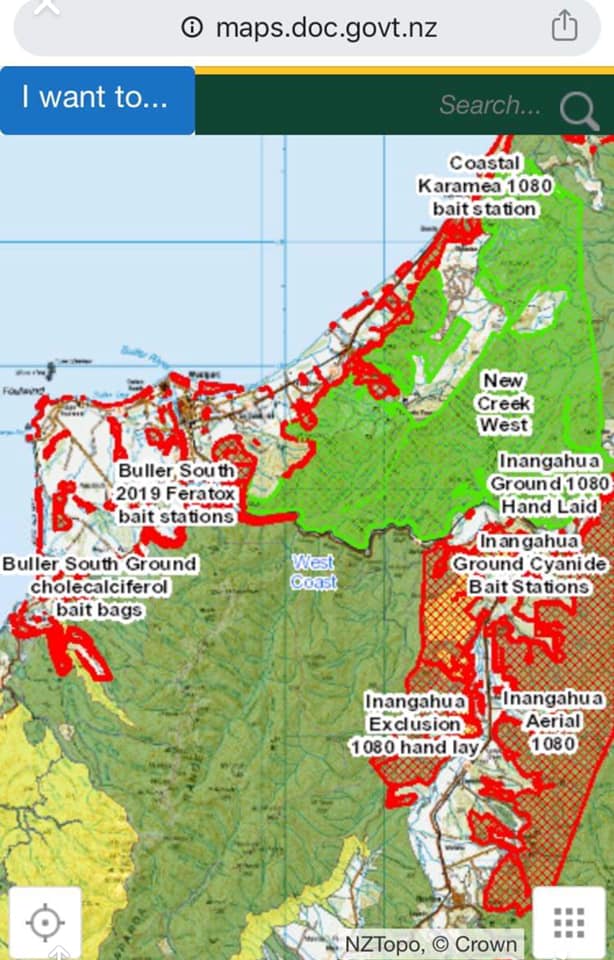
In light of the current situation with the uncertainty around Westport event, ALL scheduled 1080 drops should be halted, pending test results etc.Especially the area in the attached image from Docs pesticide summary for New Creek West outside of Westport.I have also attached screenshots of info from docs website.
It will take a concerted effort to raise awareness with a variety of organisations that, at the very least, the precautionary principle should be applied and ALL drops should be halted pending investigation (independently)I know people are angry, frustrated & just plain ‘what the hell’
Below is a list of contacts.
Please POLITELY (I know how difficult that is, but please, please be better than them) email your concerns about any drops continuing.
Copy & paste just one same email if that makes it easier for you.
But just take a little time to raise your voice 🙏🏻😊
Quicker than a coffee 😁
Keep in mind Cheryl Brunton is the medical officer who currently signs off on all West Coast drops.
Hopefully will post in comments some examples of what to write if you’re unsure 🙂
editorial@westportnews.co.nz
editor@greystar.co.nz
news@newshub.co.nz
breakfast@tvnz.co.nz
info@epa.govt.nz
paparoavc@doc.govt.nz
e.sage@ministers.govt.nz
info@bdc.govt.nz
mayor@bdc.govt.nz
info@wcrc.govt.nz
sharon.roche@bdc.govt.nz
joanne.howard@bdc.govt.nz
margaret.montgomery@bdc.govt.nz
cheryl.brunton@cdhb.health.nz
Fiona Harman to Ban 1080 - South Island |
The Hollyford Valley in NZ's South Island
was aerially 1080 poisoned yesterday
Nov 2nd 2019......again.
Here is what happened there two years ago------see above.
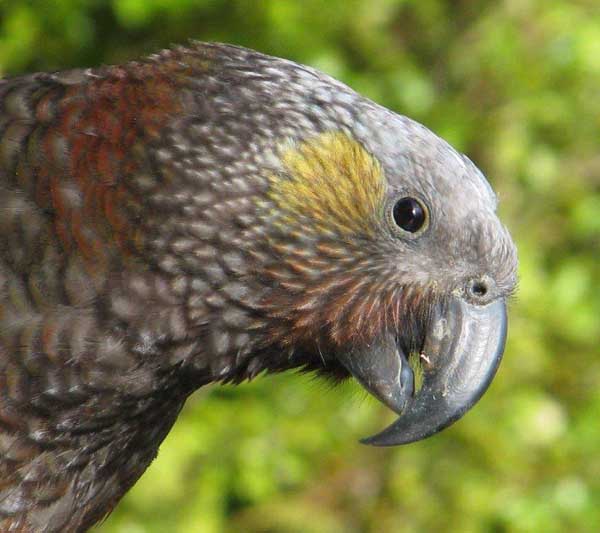
Kaka, endemic NZ parrot. ( Nestor meridonalis ) - how many will be left in 10 ys time
Photo Birding NZ
I am reposting a report I wrote in March, 2018, 5 months after the first-ever aerial 1080 drop on the Hollyford Valley, Fiordland,
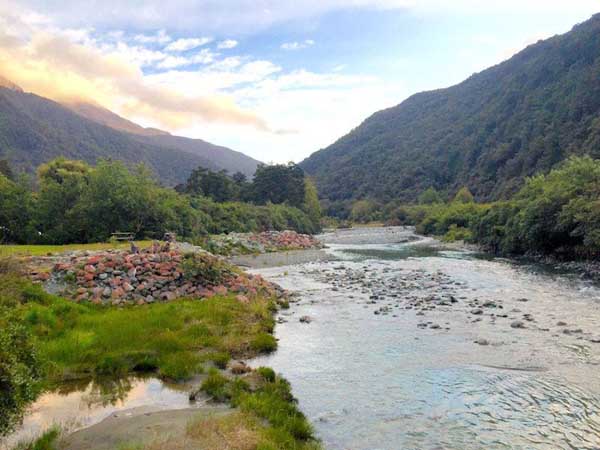
Gunn's Camp, Hollyford River, Fiordland National Park, New Zealand.
Photo Earth Burners
October, 2017. FB Ban1080 Party 5/11/2019
As a follow-up, I visited Gunns Camp in the Hollyford Valley last February, nearly 18 months after the 1080 poison drop in 2017. (All Kaka disappeared after the drop as well as other species, as you can read in the original post.) Eighteen months later up to 3 Kaka had been seen and one Morepork was heard in the distance one night according to the people who were living there (The “generator” Morepork was obviously killed by the poison.) Fantails were all still gone.

Fantail, NZ insectivore, endemic, ( Rhipidura fuliginosa ). Maori name - Piwakawaka.
Photo Birding NZ
Now I guess there will be no birds and insects left once again.... only each time the poison is dropped it will get worse. For example, the Makarora catchment, Mt Aspiring National Park, has just had its second dose of aerial 1080 two weeks ago (the first ever aerial 1080 drop there was Feb 23, 2017) and a report I received three days ago is that the people living at the Top Forks hut in the Wilkin Valley, while the hut is being restored, say it is as silent as the grave there... no birds, no insects, no life at all.
|

Gunn's Camp, Hollyford Valley, Fiordland National Park,
NZ - Photo fortheloveoftravel
From FB : Ban1080 3/11/2019: 1080 Helicopter loader working as close as
possible to the river so they can wash spillages straight in..........
This is NZ as one of the very few countries in
the world that does not ban 1080 poisoning. DOC the Dept of
Conservation lobby for more funds to spend on poisoning our lands
HOLLYFORD VALLEY, FIORDLAND - MONKEY CREEK - 1080 POISONING THE TOURISTS From FB : Ban1080 3/11/2019
DoC are getting better and better at this. Dropping 1080 poison onto tourists and into rivers.As Perrin Brown says - " tourists with no idea the creek they're drinking from could have traces of one of most deadly toxins in the world".
Sorry this has to be viewed with your head on one side
Film - Perrin Brown back in 2017.
https://www.facebook.com/carol.sawyer.3511 |
"1080 FACTORY LOSS FLAGGED WITH AUDIT NZ"
by Laura Mills - Greymouth Star, Nov 1st, 2019
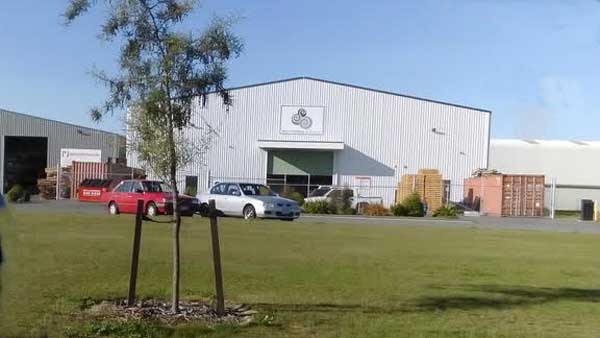
Audit New Zealand has flagged the West Coast Regional Council’s loss related to its investment in a 1080 factory at Rolleston. The annual independent auditor’s report has just been released. Auditors said the council had included in its financial statements unaudited information relating to an investment in Pest Control Research Limited Partnership — the 1080 plant.
The auditor’s report said the council’s financial statements included the share of Pest Control’s loss of $45,574, and its investment of $943,174.
“The associate (Pest Control) is not a public entity and, as such, the AuditorGeneral is not its auditor. At the date of our audit report, the audit of the associate was not completed,” Chantelle Gernetzky said. “There were no satisfactory audit procedures that we could adopt to obtain sufficient evidence to confirm the financial information relating to the associate is fairly reflected.” From: Ban1080 FB 2/11/2019
|
NO to 1080 use in NZ
October 3, 2018 · FB 31/10/2019
It is with regret we report that we have a feral Minister for what can only loosely be called Conservation.
She is abusive and evades the issues. Finally, here is the oil on Sage.
What faith can the public have in Forest and Bird or the Green Party’s support for 1080 Poison?
In 2002, the Department of Conservation on the West Coast (South Island) cut off 8.8 hectares of coastal land north of Punakaiki from Crown Land, and they issued the title Nelson 29830 direct to Eugenie Sage and Heather Wallace and their partners. Both were active senior members of Forest and Bird at the time.
Eugenie Sage was the Green Party spokesperson for Conservation, and is now Minister. This raises a number of questions and these were previously raised by Bill Wallace, Ecologist, and founder of the Ban 1080 Party:
Was standard protocol for the disposal of surplus Crown land followed?
Who within DoC was responsible for this disposal?
Was this a one-off Crown Grant, or have other senior members of Forest and Bird benefited from similar Crown Grants at other locations in New Zealand, eg Gerry McSweeney?
In the 1990s, Forest and Bird were strongly opposed to the use of aerial 1080. That changed with a management restructure.
Eugenie Sage, as Green Party spokesperson for Conservation attacked the Government’s attempts to restructure DoC. We now question conflicts of interest with Eugenie’s husband in top level management in the Department of Conservation and Sage as Minister for that Department.
Present day Sage attacks hunters and activists alike. She appears to have no filters and even used coarse language in the media today. Her department’s 1080 operations using poison and helicopters appear to target members of the public following recent allegations, and poison operations seem to be using loopholes in the legal system to forge ahead with their programs against the public’s wishes and those of the interests of invested groups within the communities.
|
Answers from the Labour-led government
are urgently needed.
Baits, tourists, poisons and cages...
Can you spot the real victims in this matter? FB 30/10/19 NO to 1080 use in NZ
DoC rejects a conflation of legislation allowing sharks to be baited to come towards manmade cages for the entertainment of tourists as a loophole in the law to stop 1080 operations while legislation is examined, as requested by lawyer Sue Grey. And DoC is also busy doing the math on how much poison they are dropping over a portion of the territory they aerial drop with 1080-laced cereal baits... twice in one operation. Doubling down on the desire to keep on with their failed programme at any cost. This double drop method appears to be the new normal and a new 'double expenditure' for the programme.
DoC was accused of only knocking on the door of backcountry huts to inform groups of 1080 operations. That is “clearly unsatisfactory in terms of health and safety obligations”, Grey wrote, as she urged DoC to “take seriously its legal and moral responsibilities”.
“You are urged to place all imminent aerial poison operations on hold until all Wildlife Act, health and safety and consultation obligations can be properly assessed and complied with, in addition to ensuing compliance with all label and other mandatory conditions of approval on the use of these deadly poison baits.”
DoC rejects a conflation of legislation
allowing sharks to be baited to come towards manmade cages for the entertainment of tourists as a loophole in the law to stop 1080 operations while legislation is examined, as requested by lawyer Sue Grey. And DoC is also busy doing the math on how much poison they are dropping over a portion of the territory they aerial drop with 1080-laced cereal baits... twice in one operation. Doubling down on the desire to keep on with their failed programme at any cost. This double drop method appears to be the new normal and a new 'double expenditure' for the programme.
DoC was accused of only knocking on the door of backcountry huts to inform groups of 1080 operations. That is “clearly unsatisfactory in terms of health and safety obligations”, Grey wrote, as she urged DoC to “take seriously its legal and moral responsibilities”.
“You are urged to place all imminent aerial poison operations on hold until all Wildlife Act, health and safety and consultation obligations can be properly assessed and complied with, in addition to ensuing compliance with all label and other mandatory conditions of approval on the use of these deadly poison baits.” |
"Carol Sawyer, an anti-1080 campaigner based in Wanaka, challenged parts of Newsroom’s story last week about a reduction, to 900,000 hectares, in the area of native forest being treated by 1080. Sawyer - who was put out by the suggestion that a reduction in area might please some of the poison’s opponents - claimed the more intensive operations would increase the poison bait being applied by “a massive 631,288kg MORE than was originally planned”. [Interesting tone of voice by Newsroom to describe a campaigner as being 'put out']
"But based on DoC’s figures, the increase is 51,035kg of bait. Given the poison comprises 0.15 percent of bait, that’s an extra 76.5kg of poison across almost 850,000 hectares of forest."
DoC doesn’t need to urgently improve its consultation practices, deputy director-general of biodiversity, Martin Kessick says.
The 1080 toxin is one of the most researched toxins in the world, he writes. It’s approved by the Environmental Protection Authority, and the Ministry for Primary Industries, and has been investigated by the Parliamentary Commissioner for the Environment but not so in USA & even some Asian countries. Look at Vietnam for instance but why not drive from Murchison to Westport & count the birds either flying or dead on the road--- there aren't any or many???? as at Oct 2019. Then ask about manganese in the water systems & bores in the North Island---- MPI nor Horizons regional council have any MAVs on the water quality for manganese???? why not/
For those reasons, deputy director-general of biodiversity, Martin Kessick argues, consultation is limited to the effects of a specific operation in a particular location???????
[That's a lot of extra killing power in a toxin that can spell death to humans at between 0.7-2mg per kilo]
(And to answer to the question above, if you think about it, the wildlife are the victims of all this point scoring by DoC, including the marine wildlife) |
DoC DROP DOUBLE QUANTITIES OF 1080 - 3KGS PER HA -
THEY COMPARE IT TO "MOWING A LAWN" ! BY cs 24/10/2019
The way one reads this, DoC have been dropping 3 kgs per ha instead of 1.5 kgs per ha !
"It was only in August that DoC realised its initial sowing rate of 1.5kg/ha wouldn't cut it with the mega mast. Nearly 20 percent of rats survived its drop in the Cobb area of Kahurangi, which is far too high.
Given the abundance of food, its thought predators were keeping to a ridiculously small home patch, of perhaps 20 square metres. The solution, Morton says, was for helicopters to make two passes, ensuring every single piece of ground is covered twice.
Regardless of what it is, if you apply large amounts of any compound (a lot of which is outright banned in other countries) you are going to get side effects...SIIM4/11/2019 see below |

He compares it to mowing a lawn.
Normally you mow whatever the width of your mower is and then you step across that area and mow the next bit. What were doing is instead of going the full width across, were only going halfway across, and mowing half the same area twice.
***************************************************************
100,000 ha lopped off the drop area... sound good ? Not really.
Still a massive 768,208ha of the South Island aerially poisoned by the Dept of Conservation in 2019, and it appears most of it has been at double sowing rates, with Wet Jacket Peninsula (39,671 ha) deferred to next year. |
[ Check this article here ]
'T CROFT LTD' DELIVERING BAITS OCT 22nd 2019 -
FOR 1080 POISON OPERATION, HOLLYFORD VALLEY,
FIORDLAND? CS-FB
Photo taken at 5.23 pm and 5.53 pm today, outside the old laundry building in Caswell Road, Te Anau, Fiordland,
There were TWO truck and trailer units... one was parked on the road while the other was being unloaded.Eyes are everywhere, poisoners!The baits are being delivered by T Croft Ltd of Stillwater, near Greymouth, and I am told they are being unloaded by Northern Southland Transport Ltd workers.The laundry building is next door to Northern Southland Trasnport Ltd's yard and depot.My guess is that they are 1080 poison baits being unloaded for the toxic part of the aerial Hollyford Valley drop... the prefeed baits were supposedly dropped last week. But I can't see an ecotoxin sign at the back, so it may be prefeed baits.The Wet Jacket Peninsula and the Waitutu Forest 1080 operations are still to come.I have been told that DoC has a contract to store 1080 poison and prefeed baits in the old laundry building for six months of the year. |
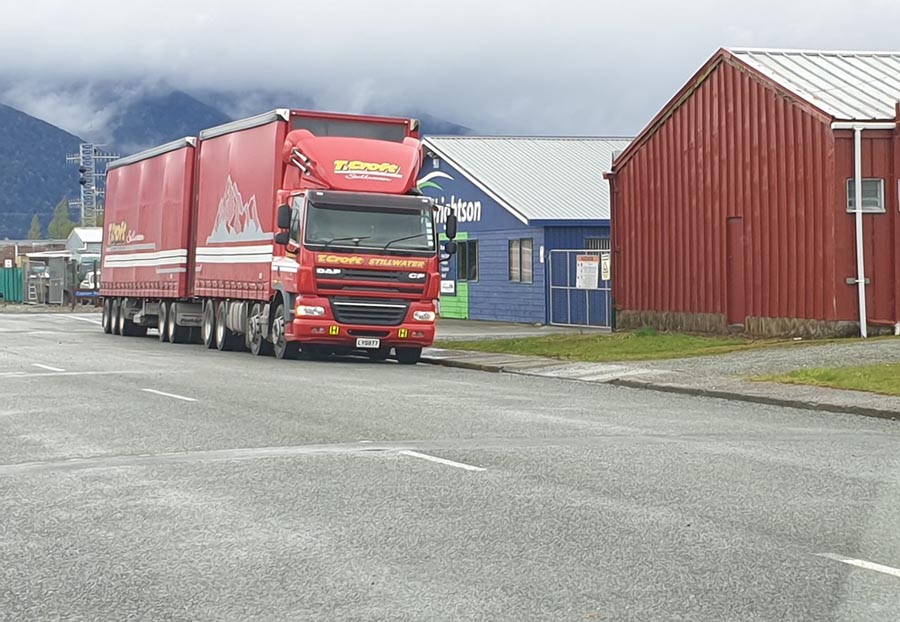
THANK YOU 'GREYMOUTH STAR' ! YOU ARE A STAR INDEED! Oct 18th FB
Another terrific article by the marvellously prolific Dr. Jo Pollard :-Greymouth Star, 18 October, 2019
As Jo Pollard says in this article, re 1080 being 'moderately humane': "Of all the official misrepresentations of 1080 this one seems to reach the lowest moral ground of all."
As Jo Pollard says in this article, re 1080 being "moderately humane": |
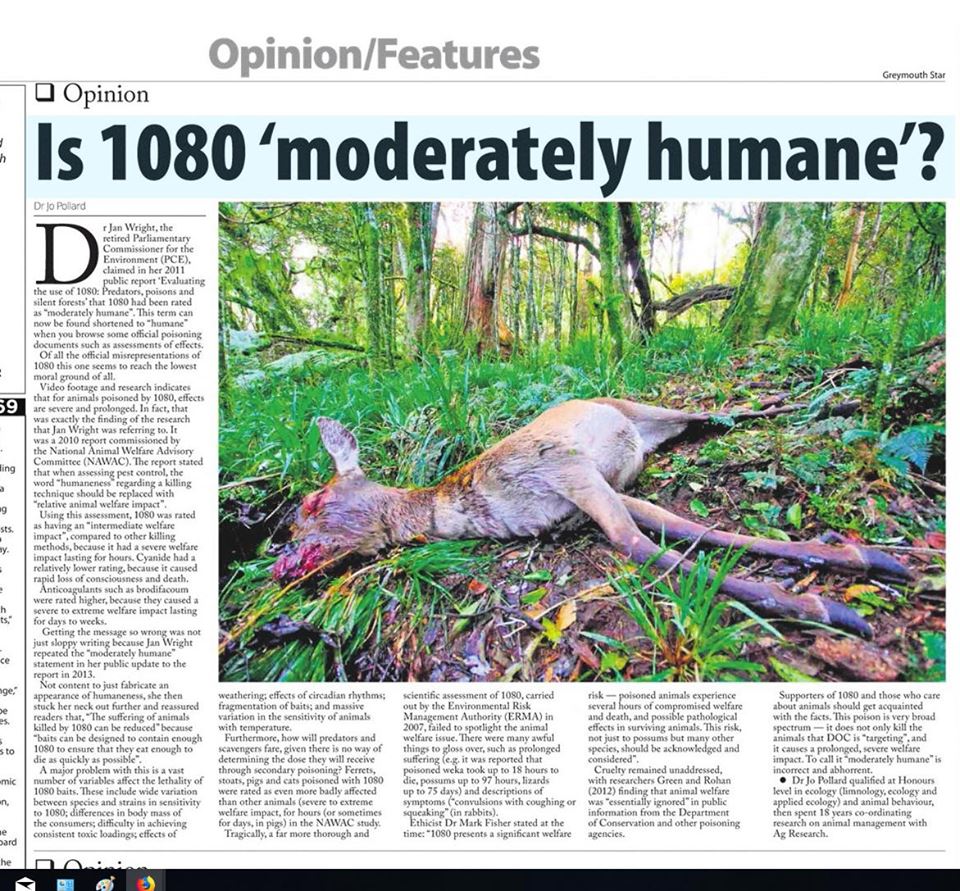
FB: COMMENT: Humane = killing without inflicting pain ,inhumane=killing with inflicting pain and a torturous death ,moderately humane = killing with just a moderate amount of pain !DOC and their counterparts are inhumane killers ,they kill with the inhumane poison called 1080 ,I suspect they are in a lot of ways sadists wholike inflicting the most horrendous pain on animals and humans cause that poison does not diferrentiate between a human or an animal ,it kills with the ultimate amount of pain !! |
THE MAKARORA AREA WAS AERIALLY 1080 POISONED AGAIN LAST WEEK - 39,000ha. FB CS-22/10/19
This area had never been aerially 1080 poisoned until February, 2017,
when it was 1080 poisoned for the first time. (See story of that 2017 drop attached).
TWO TONNES 1080 BAITS PER RAT !
Two tonnes of 1080 poison baits were dropped per rat in 2017......the poison drop was aimed at approximately 43 rats ( only 1.9% of 2,280 tracking tunnels had evidence of rats over a two year period, Jan 2015 to Dec 2016). Read on:I have a copy of the Otago Regional Council's recommending report (5/9/2016) re the Department of Conservation’s "application to discharge pesticides onto Regionally Significant wetlands within the Matukituki and Makarora River catchments".It states that the operational targets were:"To reduce possum numbers within the area to a residual trap catch (RTC) index of 3 possums per 100 trap nights or less (♥% RTC), immediately following the operation
and
To reduce rat tracking tunnel rate to LESS THAN 5% within one after bait application."However, in response to an OIA request before the drop, a “Makarora data” file was provided. This showed that DoC had looked for tracks of rats, mice and stoats in 2280 tunnels in total between January 2015 and December 2016.
ONE POINT NINE % of the tunnels contained rat tracks, 28% of the tunnels contained mouse tracks, and 1.4% contained stoat tracks. |
Therefore there was NO justification for the drop –
1080 is ineffective against mice and it is likely to cause plagues of them, as well as kill native birds.There were very low numbers of DoC’s target predators (rats and stoats), and way below the supposed target... BEFORE the drop.This did not stop them. They went ahead anyway.Now there are reportedly high rat numbers in the Maakrora catchment area. This is not surprising. We know that 1080 causes rat plagues. DoC's own science tells us so.So poor old Makarora is now on a two-yearly ( or less) 1080 poison cycle. |
https://envirowatchrangitikei.wordpress.com/2017/02/26/tributaries-that-flow-into-the-blue-pools-lake-wanaka-have-been-poisoned-with-1080-no-signs-out-tourists-oblivious-to-swimming-risks-ingesting-the-water/?fbclid=IwAR0HXN7SofMAxLGco9YRyDxF10i32jV688nywUyEb4VNe4U672JzZNF3HRs
WANAKA SUN... GET YOUR PHOTOS
RIGHT FOR GOD'S SAKE!
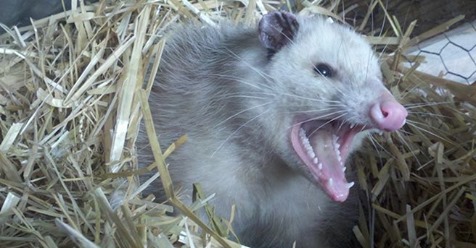
The above pic is not a opossum?? How Wanaka News media make a bad writeup
Well done, Tony Orman ! However the stupid Wanaka Sun still doesn't know it's opossums from its possums. Or perhaps it wants its readers to think our pretty possum looks like a nasty snarling creature because that suits its purposes ? (But this is the second time it has posted this photo, despite complaints, so I think they are doing it deliberately.)
The poor creature pictured here has absolutely nothing to do with the Australian Brushtail possum we have in NZ... which is a beautiful and harmless herbivorous creature that has one baby per annum. (The North American opossum has masses of babies per annum, eats birds, lizards, eggs, dead carcasses, and bones, and looks fierce. But is has its place in the N. American ecosystem, obviously.)
Our beautiful little ( now, by length of habitation, surely Australasian) possum is a gentle soul, that loves, and nurtures for a long time, its one baby per year. It makes an amazing pet, and never, ever deserved the awful reputation it has been given !!!
Talk to anyone who has raised a possum joey. They fall in love !
Protected in Australia, sadly in NZ the possum has been demonised. It has been blamed for spreading bovine TB without a single shred of scientific proof and with no known method of transmission.
It has been blamed for deforestation. That too is a nonsense. See the following:
https://www.landcareresearch.co.nz/…/possum_native_vege.pdf…
and
|
WHY POSSUMS ARE NOT A THREAT TO OUR FORESTS - GRAHAM NUGENT'S
(Landcare Research scientist ) VIEW - so why is the New Zealand Government trying to poison them out of existence ? :
Tony Orman writes - At a Department of Conservation workshop held in the mid-1990s on "Possums as Conservation Pests”, respected scientist Graham Nugent of Landcare Research, spoke on the subject.
Assuming the oft-quoted figure of 70 million possums in New Zealand, the marsupials "apparently consume about 21,000 tonnes of vegetation per day - presumably 300 g wet weight consumption multiplied by 70 million possums," he said. "This oft-quoted figure is frequently used to depict possum as a rapacious consumer of all things green,” he said obviously rebutting the idea of a possum as a threat to vegetation.
"But," added Graham Nugent. "that implication ignores the trees’ daily foliage production of 300,000 tonnes for forests alone - 7.5 million hectares x 15 tonnes wet weight of foliage per hectare per year."
In simpler words, the fictitious number of 70 million possums would gobble only about 1/15th or 7 percent of the new foliage each night.
It would be less because most possums live near margins of forests adjoining paddocks rather than in the forest and a significant part of their diet is grass or spring and summer growth on farm trees like willows, growing outside the forest.
Graham Nugent termed the 70 million possum "guess-estimate" by DOC as a "back-of-a-cigarette-packet" calculation. Recently DOC have tended to reduce the "estimate" of the total possum population down to about 35 million. Even that could be far too high.
And let's take a more realistic figure of perhaps 10 million rather than 70 million possums. If a more realistic national possum population of 10 million is used, they would consume just one per cent, of the daily foliage production.
Is that a forest pest?
Graham Nugent went on to say that possums do not threaten the total national forests by deforestation. For the bulk of New Zealand's forest, the process is one of a change in individual species known as composition. There would be less of palatable vegetation species. So the change is merely a structural forest change.
( With thanks to Tony Orman for sending me this piece, and thanks to Morton Bartlett for the Landcare Research link)
|
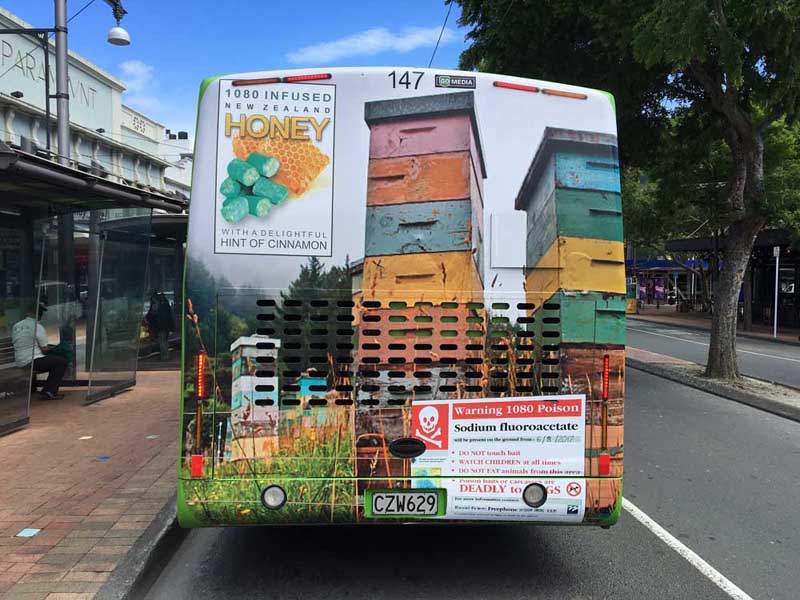
Separating Fact from Fake News: Check link here: Facts 4 Friday.
What happened to the 1080-poisoned employee in Christchurch?
We already know through various sources and Official Information Act (OIA) responses that since their establishment as a (toothless) Government authority, WorksafeNZ has (conveniently) only identified one, single workplace incident recorded as being related to an employee poisoned with 1080. That incident was located at the Pest Control Research (PCR) site in Wickham Street, Bromley, Christchurch on Wednesday 29 May 2019.(Google Map: Image 1) At the time, Fire & Emergency NZ (FENZ) were NOT called (or notified) of this serious poisoning event (reasons for this are unknown). (The subsequent TVNZ news reports claim that the poisoning incident happened on the 28th May, so perhaps there was a delay in PCR reporting the incident to Worksafe?)
Two days later, on Friday, 31st May, FENZ Assistant Area Commander, Christchurch area, Steve Kennedy wrote an email to all the Christchurch Fire & Emergency stations warning them about the extreme risks from the poison contaminated site (OIA Image 2). He lists three poisons involved, and we know from OIAs that at least one (likely the shortest redacted word in the text of the email) was 1080. Note that the combined effect from 3 highly toxic hazardous chemicals is very dangerous – the potential consequences for public health are completely unknown so any risk assessment is impossible.
The Precautionary Principle SHOULD have been adopted immediately: all areas should have been evacuated until public safety was assured. But the building was simply padlocked by Worksafe and there was no evacuation – even at the swimming pool next door where children innocently played...
TWO WEEKS LATER, Fire & Emergency NZ were in attendance at the site on the morning of 12 June 2019. Reasons for this delay are unclear. However, it would appear there was a report of an explosion at the same site that morning. On the FENZ incident report, it was noted that “[X?] Has information that there was incident at this address earlier today (12 June) that R(?)call from (FENZ) National Hazardous Substances Advisor based in National Headquarters Trudy Geoghegan resulted in an explosion.” It is not known why the report of an explosion did not come directly from the Bromley area.
From the very beginning of the FENZ visit to the contaminated site on 12 June, their Media Spokesperson Mark Scott was involved. They know poison use in NZ is a highly sensitive issue and the public has a right to know the risks. But the various news broadcasts on that day did not include Mr Scott: all media queries were directed to Worksafe. It is unknown what information had been provided by Steve Kennedy or others to Mark Scott. Certainly there is concerning evidence that the fire crews themselves seemed to be completely in the dark about what the hazardous substances were they were dealing with at the site and how they were to address the risks (to themselves and the public).
For example, even after 5pm on 12 June, the FENZ Incident Report records “Unknown what safety measures would be required but Breathing Apparatus wearing at the very least. Could be toxic or corrosive or both. The actual substance is not identified at this stage. If for whatever reason we get responded to this address tonight Worksafe is NEE. There is a possibility that there is a hazardous gas inside the building and the actual name of the business is unknown […] FENZ was not called [to] the original call. Building has been secured by Worksafe with padlocks.” (see image 3).
Shockingly, it was only at this late point in the day - 17.20 - that the FENZ incident report finally mentions Steve Kennedy’s crucial email dated 31 May. No-one had been evacuated and presumably no-one even knew what the symptoms of 1080 poisoning were, what they were testing the building (or staff) for and how to ‘decontaminate’ the area. For instance, were the drains sealed around the hosed-down areas, the water-table tested? What risks were staff, volunteer crew and the nearby public subjected to, during that day? And during the 2 weeks prior to their attendance at the site? Has anyone living/working /visiting that Bromley retail & industrial site been interviewed or checked for health problems? Why did Worksafe ‘padlock’ the building but NOT take any further action for two weeks, putting the public at serious potential risk?
What has happened to the employee who was rushed to hospital on 29th May? We wish him/her all the very best for a full recovery and fully respect the family’s wishes for privacy. BUT why weren’t FENZ and the public notified of the potential serious risks from 1080 (and other poisons) contamination in that area?
Unfortunately, Worksafe have refused our request for copies of the correspondence between Mark Scott and/or his colleagues at Worksafe and Fire & Emergency NZ between 29 May 2019 and 12 June 2019, which would provide some insight into what exactly happened. This is because {quote} “WorkSafe’s investigation is not yet completed and its release (which could take up to a year) could prejudice the maintenance of the law.” Mmmmm are they hoping that we might all forget? Not likely!
So we will wait to see whether Worksafe will accurately report the poisoning incident, but looking at their track record, we won’t hold our breath. Neither will we expect any prosecutions as a result of breaches of the Health and Safety at Work Act, because seemingly that isn’t Worksafe’s remit: the poison cover-up and corruption continues – but we’re confident it’s NOT for much longer.
|

IS HONEY IN NZ SAFE
Registered by DoC as a wasp bait, 1080 is being gathered by bees & NZ has no accredited test for it in hone. CHECK HERE:

There are more than 1,080 reasons not to use sodium fluoroacetate in the environment. That it is an insecticide is one. This wildlife poison is also licensed for use against wasps in New Zealand. The World Health Organisation classes 1080 as highly toxic to bees. Baits dropped from helicopters contain sweeteners. Bees carry food back to the hive. Why is our honey industry not kicking up a huge fuss at government level about this? |
Show us the money, honey.
https://uncensored.co.nz/…/registered-by-doc-as-a-wasp-bai…/
2 honeycomb samples tested LR Lab Tongariro National Park 0.009 ppm 1080 poison 2003 – 8 years after 1080 jam banned. No further 1080 tests despite this obvious threat to consumers. Other toxins found in bees from DOC “pest control” operations. 32 dead bees, washed prior to analysis 7.86 ug/g pindone 37 dead bees, washed prior to analysis 4.03 ug/g pindone 52 dead bees, washed prior to analysis 3.64 ug/g pindone 25 live bees, washed prior to analysis 0.74 ug/g pindone
1 of 2 bees found dead 90.3 ug/g pindone The highest concentration of 1080 detected in the honey was 15 ppb and subsequent tests showed a gradual decay down to 3 ppb after 59 days. The honey source that the samples were taken from would have eventually gone on sale after 16 weeks, hence there would not have been any detectable level of 1080 in the sale product, although under different circumstances, this time could be considerably shorter. Zero studies were done to see if the 1080 samples “lost” 1080 due to the toxin binding to the plastic sample pots – 1080 is well known for binding. What this could mean is the samples tested lower over time while the drums of honey remained high and were then sold. 1080 IN HONEY FROM POSSUM BAITS RAHOTU – TARANAKI Murray Lowe HEALTH PROTECTION OFFICER TARANAKI HEALTHCARE |
Poison drops in the South island NZ
killing our wildlife
THE REAL TRUTH ABOUT AERIAL DROPPED 1090 POISONED FOOD
[ Check the full story here ]
FB Comment: "It's not just the environment getting poisioned ,our society is being poisoned the goodwill and friendly people of our country are increasingly threatened and marginalised by a minority .
I can't help but laugh when I hear the PM talk about social well being .
Our country is being torn apart by the lack of consensus and a few trying to dictate their ideals to the rest of us .
Our society's well being is at an all time low---totally correct".
The results are not good for birds! Did you know Possums need only consume 0.4 % of their daily food ration in 1080-poisoned food, yet a smaller tomtit-sized bird with normal to high tolerance need only consume 0.6 to 1.2 % of its daily food intake to reach a lethal dose. A larger kea-sized bird would require only 6 to 12.5% of their daily food ration in 1080-poisoned food to reach a lethal dose. Clearly, 1080-poisoned food, as used in New Zealand’s aerial poison drops, has the capacity to easily kill both mammals and birds if it’s ingested in quantities that are small relative to the normal
eating habits of these creatures. |
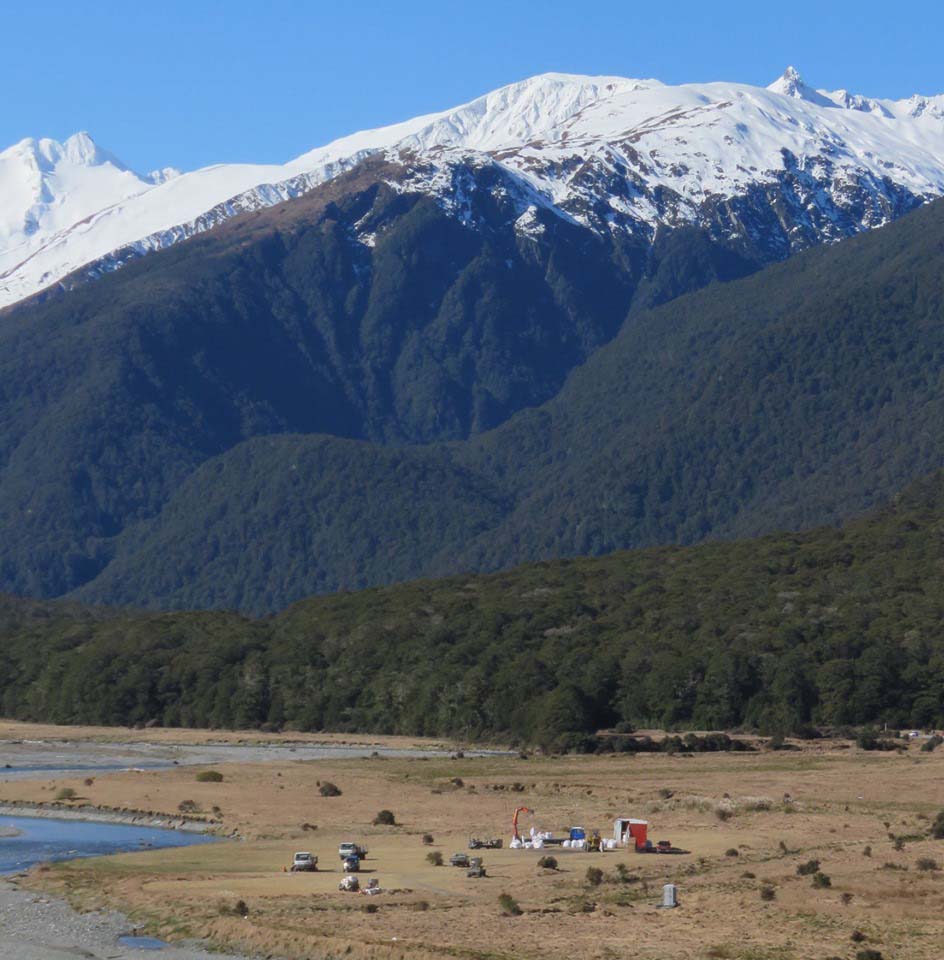
Long-term benefits of aerial 1080?
Consider evidence supporting the hypothesis that benefits to birds
outweigh the risks. In reality, an extremely low number of reports have explored long-
term effects of aerial-dropped poisoned food to birds. The potential benefits of a
1080-poisoned food operation to a particular bird species are indicated by a decreased
death risk to a 1080-poisoned food exposed population. To evaluate long-term
benefits, an unexposed control group is essential, as well as longer-term follow ups of
the tagged birds at 1 to 4 years after the 1080-poisoned food operation. The
unexposed control group gives the death risk rate by natural factors, including
predation. Therefore, by simply including a longer-term assessment of the very same
experiment that had already been invested in, basic statistics (called relative risk
ratios20) can be used to provide concrete evidence of the relative short-term risks, and
some of the potential long-term benefits, of an aerial 1080-poisoned food operation to
a particular bird species.
Unfortunately, in the 23 years of collected data a control group has rarely been used at
all, with 36 of 49 experiments (or 74%) performed without a control! This is appalling
scientific practice! Of those experiments that used controls, the vast majority of
experiments followed-up tagged birds to only 3 weeks after the poison operation.
The one report I located that followed up birds 25 months after the poison operation
found no difference in the lifespan of birds in 1080-treated and untreated areas,
indicating no survival benefit at all.
Increased breeding success with aerial 1080-poisoned food induced predator removal
might benefit specific bird populations in the long term. However, I could find only 3
studies reporting on nesting success of 4 bird species after aerial 1080-poisoned food
operations. Two of these 3 studies concluded with no significant differences in
breeding success! For instance, in spite of a high death rate observed for tomtits in
some aerial-1080 operations, the breeding success of tomtits in an aerial 1080 treated
area was not significantly different from that of an untreated area. The breeding
success of kaka was also not found to be significantly different with 1080 treatment.
Only kereru and robins showed increased breeding success in one to two breeding
seasons following 1080 treatment. There is no information at all that looks at the
longer term 3-4 year adult lifespan or breeding success of New Zealand’s birds with
aerial dropped 1080-poisoned food. At best, there is only very minimal evidence
regarding longer term benefits of an aerial 1080-poisoned food operation in terms of
breeding success.
Read more on the link above OR BELOW.
Our thanks to Alexis Mari PietakDr Alexis Pietak is a biomedical research scientist, biophysici st, and author who lived in New Zealand from February 2005- May 2011. More information about Dr Pietak can be found ON HER WEBSITE [ HERE ]
CHECK BAN 1080 HERE : they need your support, shares & comments
https://www.facebook.com/ban1080party/

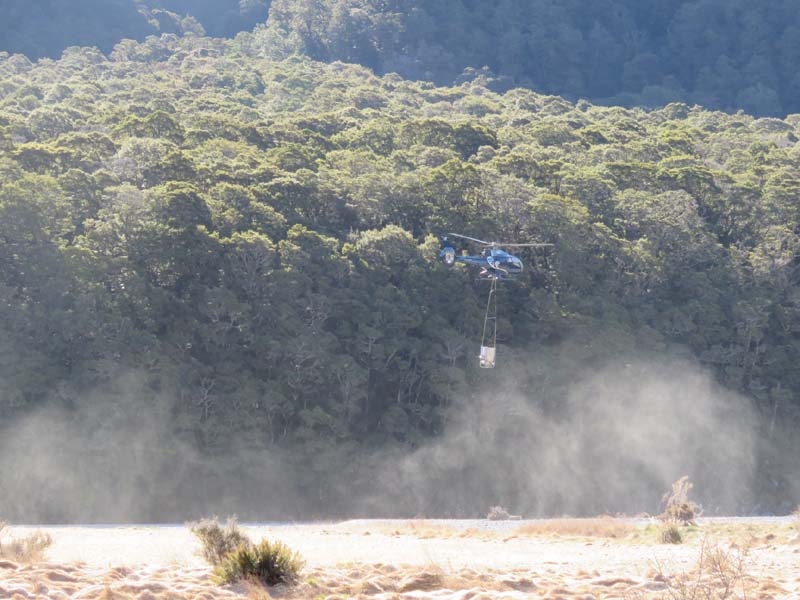
LATEST SOUTH ISLAND OF NEW ZEALAND 1080 DROPS
SEPTEMBER 2019
MAKARORA, MT ASPIRING NATIONAL PARK, AERIAL 1080 OPERATION.... PREFEED BAITS DROP-- all Tourists please take precautions if hiking near these areas?
Sad to be looking at this on such an absolutely beautiful day, in what must be one of the most beautiful places in the world, and knowing that the chaffinches, grey warblers, and harriers I heard today will be silent in a week's time.
Seems the place was crawling with security guards, and they were all taking photos of us and we were trying to take photos of them taking photos of us. I don't know what they were scared of ! Facebook I suppose, but I don't put recognisable photos of people up so they needn't have worried. (We just felt that if they were taking photos of us we should be taking photos of them !) Anyway they scurried behind cars and ducked and dived behind bushes, and hid their faces.
|

MAKARORA, MT ASPIRING NATIONAL PARK, AERIAL 1080 OPERATION
There were four helicopters working. -
ZK-HKR, a Jetranger
ZK-ICR, a Squirrel
ZK-HXZ, a Hughes 500
ZK-HKW, a Eurocopter EC130 B4
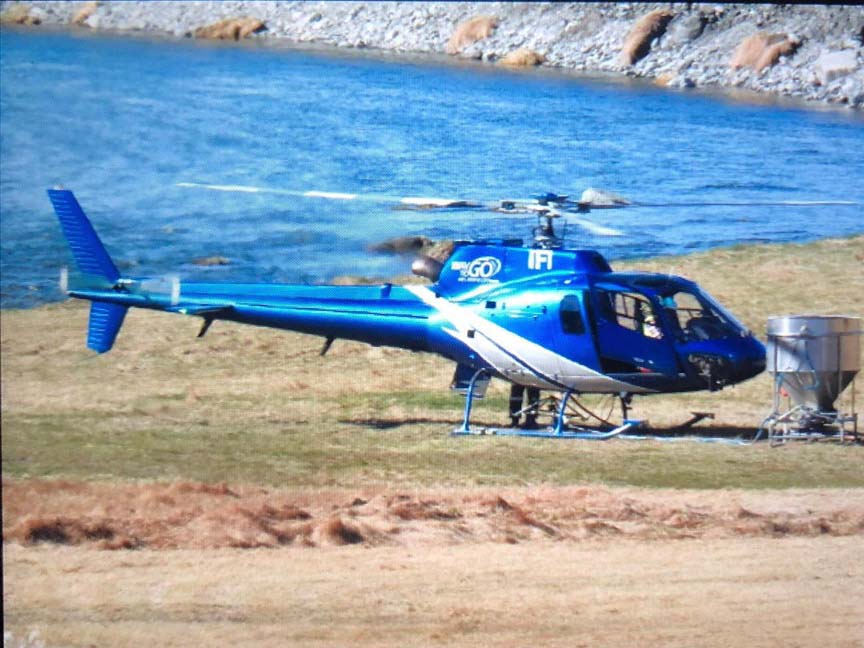
MAKARORA, MT ASPIRING NATIONAL PARK, AERIAL 1080 OPERATION
I was told the drop was by Way to Go Heli Services, Rangiora. The Eurocopter EC 130 B4 and the Hughes 500 are their own helicopters. The other two may have been leased for the purpose.
Please note the terrific dust clouds generated by ZK-HKW when loading, and imagine that dust coloured green, and toxic, in the actual 1080 poison drop in a week's time.
JJ Nolan Transport Ltd of Haast is the transporter pictured, and while we were there another 'JJ Nolan' truck, a double curtain sider came whizzing past us, ignoring the 30kmph sign. It was probably headed to Glenorchy with the prefeed baits for the Dart, Caples and Routeburn Valleys 1080 operation which starts tomorrow. |
https://www.facebook.com/carol.sawyer.3511/posts/2447374865542825
NZ DUMPS TONNES OF 1080 POISON OVER THE GROUND;
NATIONAL PARKS AND DESTROYS DEER, BIRD, INSECTS
AND WILDLIFE IN THE NAME OF CONSERVATION
The quality of scientific evidence matters!
SO HOW DOES DOC KNOW IT WORKS
WITHOUT KILLING BIRDLIFE ETC
Theres a need to consider the quality of scientific evidence that’s being used to
support the hypothesis of low bird death risk with aerial-dropped 1080-poisoned food.
The academic community has previously determined that the only reliable way to
assess bird deaths from aerial-dropped poisoned food is to capture birds, mark them
with a coloured band or radio transmitter, release them, and look for them after the
poisoned food drop. This is called a ‘mark-recapture’ method. Other methods, such
as the 5 minute bird call and count techniques often mentioned in DoC’s reports,
produce nonsensical data unless the whole bird population is wiped out after a poison
drop. The reason for this is that using non-marked techniques, differences in bird
behaviour cannot be separated from differences in bird abundance. The weather,
presence of a human observer, and unknown bird behaviours are all factors causing
daily sightings to go up or down independent of actual bird populations. In short,
mark-recapture experiments are considered to be the only way to get a reliable
assessment of bird death risk with aerial-dropped poisoned food exposure.
Our thanks to Alexis Mari PietakDr Alexis Pietak for allowing us to publish this information
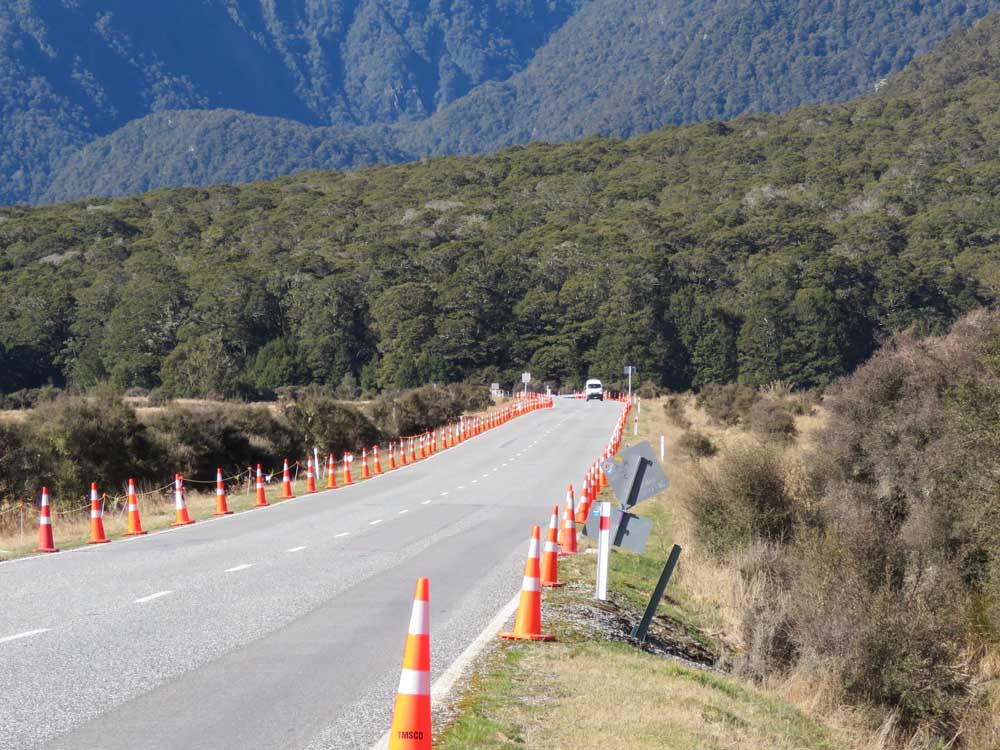
Road cones for Africa... no vehicles may stop here to watch the 1080 poison operation, Makarora River, Mt Aspiring National Park, South Is New Zealand September, 2019.
The wilderness being poisoned by 1080

Ready to rain 1080 poison over the hills of the South Island
NGAI TAHU TRIBE IN THE SOUTH ISLAND NEED TO PRESERVE WILDLIFE----- OUR TIPUNA ARE WATCHING YOU. Money & position doesn't determine the very nature of our heritage......protect life not destroy it for gain. Who we will blame when our native Kea etc are no more??? |
September 18 at 6:40 PM
DART, CAPLES & ROUTEBURN VALLEYS, MT ASPIRING NATIONAL PARK -
AERIAL 1080 POISON DROP 20 SEPT, 2019

From: bfobwakatipu <bfobwakatipu@doc.govt.nz>
Date: 18 September 2019 at 4:13:00 PM NZST
Subject: Notice of aerial 1080 operation 2019: Dart, Routeburn and Caples Valleys
This email is to confirm that the aerial application of poison cereal baits containing Sodium Fluoroacetae (1080) in the Dart, Routeburn and Caples Valleys will occur on Friday 20th September.
From late Thursday 19th September and all of Friday 20th September the road to Chinamans Bluff (Dart Track) will be closed from the forest edge at the top of Mill Flat.
All tracks in the Dart, Routeburn and Caples will be closed during the drop. Nearby tracks will also be shut including Fraser and Kay Creeks, the Rock and Beans Burn and the Routeburn North Branch. These closures will be up to 24 hours. Overnight trampers already within the area will be held at huts by DOC staff until operations are complete. People planning to visit these areas are advised to check with a DOC visitor centre prior to their trip.
Immediately after the drop the tracks will be inspected by DOC staff and swept for pellets before being reopened. Please note some pellets may still be found on the tracks, particularly if it is windy.
If we encounter difficult operating conditions the aerial work may continue into Saturday 21st September. If this occurs, both the road closures and track closures will continue for this extra day. .......
|
https://www.odt.co.nz/regions/queenstown/popular-tracks-closed-1080-drop?fbclid=IwAR1bz6vMy0BiZ7gwrRWMGVoONpxmgzQXq3EHPECdr_io2esyPrKe9c9hkNE
Department of Conservation
Whakatipu-wai-Māori / Queenstown Office
Cavells Building, 1 Arthurs Point Road | PO Box 811, Queenstown 9371
www.doc.govt.nz
WHEN TOURISTS SEE SUCH A WONDERFUL SPECTACLE THAT HAS BEEN PRONE TO POISON WHAT DOES ONE THINK

BREAKING NEWS RE THE HOLLYFORD VALLEY AERIAL 1080 DROP ! Sept 18 2019
I have had a report today, (as yet unconfirmed), that an injunction has allegedly been taken out by Ngai Tahu against the upcoming Hollyford 1080 drop, and that it may either be held up or not now go ahead. I will keep this updated if and when I hear more.......
INDEPENDENT FB COMMENT: How can a Government (prime minister Jacinda Adern) agree with putting some toxic 1080 in such a Beautifull area, they have been sucked into believing this is right, obviously they have NO Connection to our planet, or universe, Nature has a natural way of Balancing itself, who are we to think other life forms aren't allowed to exist,our cells heal from Nature, and now there poisoning it. Bad KARMA for those responsible,
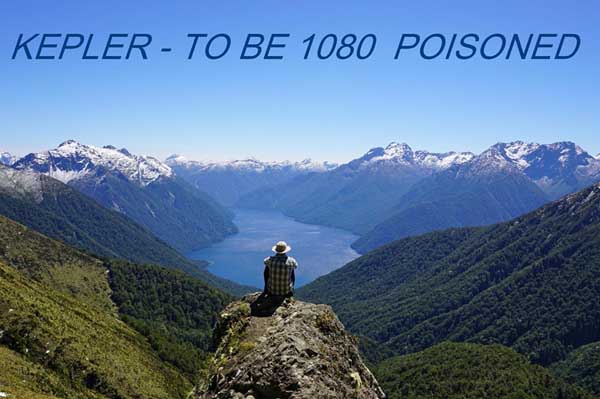
24 HOUR NOTIFICATION OF AERIAL 1080 POISON DROP ON KEPLER MOUNTAINS AND KEPLER TRACK. South Island NZ
Sept 18th 2019: Copyright of Carol Sawyer FB. Subject: 24 Hour Notification - Toxic Phase of the Kepler Aerial Pest Control Operation - Tiakina Nga Manu
Good Morning,
Please take this email as 24 hour notice for the Kepler Aerial 1080 Pest Control Operation.
Prefeed was completed on the 9th of September, the toxic phase is planned to start tomorrow the 19th of September. The operation should be completed in one day.As a result the following tracks will be closed for the duration of the operation:
-Kepler Track Warning signs will be put in place. A reminder to please check for signage if you are in the area. And;
DO NOT TOUCH poison bait
WATCH CHILDREN at all times
DO NOT EAT animals from the area
Poison bait or carcasses are DEADLY to DOGS
Administrative Support
EcoFX Limited
PO Box 248 Otorohanga
EcoFX, "Protecting Your Natural Heritage
INDEPENDENT COMMENT on FB random: NZ Government is run by Muppets and Puppets NOT ONE ☝🏻 of have Got Balls to make a stand against the Total Banning of 1080 Poisoning, as for DOC ( Destroyers of Country) The Forest and Bird Society ( No Forests and No Bird Sect ) wasting Millions up Millions of Dollars Poisoning New Zealand to become DEAD-LANDS OF ĀOTEAROA
DoC RETALIATES WITH SICKENING PROPAGANDA !
The Dept of Conservation has responded to Dr. Jo Pollards article in the Greymouth Star, September 3, 2019, "Time to Think about Kea", (see below if you missed it), with an article entitled "Time to Help our Kea", 13 September, 2019. (see attached). Bunch of hypocrites, but what's new ? Who among us does not now know that 1080 poison is wiping out Kea ?!
WHO TO BLAME WHEN NZ'S KEAS ARE NO MORE
& DOC LISTENING TO A REPORTER DOESN'T QUITE FIGURE ???
Please check letters in the Greymouth Star....Geoff Guenole and John Veysey on 11 September, 2019, and Jean Rogers on 9 September, 2019.
Jo Pollard's article
TIME TO THINK ABOUT KEA
by Dr Jo Pollard (BSc (Hons), PhD)
Published in the Greymouth Star, September 3, 2019
"The kea, NZ’s unique mountain parrot, needs urgent consideration. This spring, poisonous food baits are being spread by air over much of its habitat by the Department of Conservation (DoC).
Twelve per cent of resident kea are expected to die within a few days of the poisoning, according to DoC’s studies.
Debilities such as damaged wing muscles and reproductive defects are expected in those that are sub-lethally poisoned.
Thus the few (possibly 1000-3000[1]) remaining kea in NZ face major genetic loss and suffering. DoC needs a strong argument to justify this mayhem.
Please check letters in the Greymouth Star....Geoff Guenole and John Veysey on 11 September, 2019, and Jean Rogers on 9 September, 2019.
DoC has taken to sheltering behind pro-poisoning freelance journalist Dave Hansford. Recently, Hansford repeated DoC’s message to the public that kea will be better off after poisoning. He argues that filling our forests with toxin will stop stoats from ravaging kea nests. Hansford went on to soften us up claiming that a death rate of up to 22% of kea will be ok this spring - by DoC’s reckoning.
Ever since DoC finally recorded that many kea were dying in aerial poison drops (as people had been telling them for decades) it has been on a desperate search for evidence that poisoning somehow benefits kea, in an attempt to prove that these awful losses might be somehow justified.
DoC chose to argue that stoats endanger kea and that poison will solve this. But DoC’s own scientists, and research before them, had already concluded that stoats were not a problem to kea.
In vain, DoC has been trying to amass evidence that stoats are endangering kea. DNA tests, attempts to analyse bite marks and thousands of hours of videos of kea nests have yielded very little. This is despite the videoed nests being made known and vulnerable to any predators, by disturbing the birds thoroughly (including volunteers, dogs and others hunting for nests; visiting repeatedly; taking blood samples; marking sites; attaching harnesses to adults and chicks.)
But Hansford says there is evidence that 1080 helps kea, in a paper written by DoC staff, published 2018. That document rests its case on an experiment in Westland, which DoC had previously self-criticised as unreplicated and lacking objectivity! Not only is the study unscientific, the results are presented in a fraudulent manner. A stoat plague that followed aerial poisoning at Okarito, shown in the original report, was truncated from the published graph!
Another incorrect statement, repeated by DoC, Hansford and other poison supporters is that kea in remote areas, that are unfamiliar with people and being fed, will be relatively safe in poisoning operations. DoC’s own results do not support this: 9% of monitored kea died at Kahurangi, a site chosen by DoC for its remoteness.
Kea are in fact extremely curious and resourceful regarding food, willing to try anything. This trait is thought by scientists to be a response to living in a very challenging nutritional environment, where starvation typically kills off many juveniles in an average year, as well as many adults in poor seasons.
Before poisoning, “pre-feeding” with normal, unpoisoned baits is carried out to build up animals’ confidence. This will encourage kea to eat the bait regardless of their background. In this year's toxic deluge, some baits will be coated with blood, in an attempt to repel deer. This practice is normally prohibited in kea habitat because it is likely to attract kea even more.
DoC pretends that aerially spreading 1080 poison is good at controlling pests. The truth is mice don’t normally eat it, rat numbers often rebound ferociously, and stoat numbers can escalate when either of these previous two rodents flourish. DoC’s (and pest control company ZIP’s) response to this is to use more dense, and more frequent poisoning. This is madness when up against the rat, considered by at least one biologist to be so hardy that it will be the last animal on earth when all else is gone.
DoC also pretends that 1080 poison doesn’t kill many animals other than the ones it wants dead. The toxin interferes with respiration so it affects all creatures that breathe air. Kea are one of very few native animals whose deaths have been monitored with any reliability. The death toll of many other creatures may also be large.
Entomologist Mike Meads found severe effects on invertebrates, in a study that was initially supported by peer reviews but later discredited by DoC, and which has never been followed up with a comprehensive, replicated trial. A study on stream invertebrates also showed negative effects of 1080 but was also never followed up. Fernbirds died at a rate of 9.4% per poison drop. Kakariki parakeets are known to be killed in 1080 operations yet, incredibly, the baits are to be sown at double density where the last remaining orange-fronted kakariki in Canterbury are clinging to existence (only 100-300 birds left).
What benefits will there be from spreading 1080? Poisoning documentation for the Arthurs Pass area states “the overall net effect on the ecosystem will be one of profound benefit”. Not surprisingly this claim is unreferenced! DoC has scrambled for credibility recently and published several studies (on birds), which all suffer from poor scientific methodology and fall well short of demonstrating overall benefit to any species, let alone ecosystem-level benefits.
Kea expert Paul van Klink complained last year that there was no management plan for kea and that DoC and its volunteers were knowingly killing kea in traps set for stoats. Further investigations by reporter David Williams painted “a picture of a department that is unsure of the risks, or efficacy, of the traps it’s using, managers that make decisions while seemingly ignorant of trap trial results, and decisions being made about positioning traps seemingly with little scientific basis.”
So the senseless, science-less poisoning is only one symptom of DoC’s incompetent management.
Thinking people need to stop swallowing the outrageous propaganda emanating from DoC, and look at how things stack up for the kea. It is currently facing an extremely bleak future.
[1] Estimates as low as 1000 have been made since 1986" |
DOC listening to a FREELANCE journalist. Hansford is not a scientist
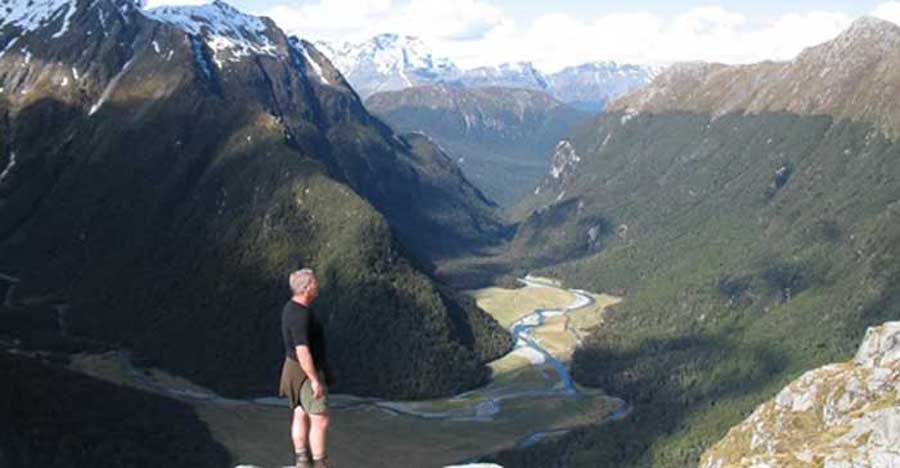
POPULAR TOURIST WALK TRACKS CLOSED DUE TO 1080 POISON- from Otago Daily Times
Aerial drops of 1080 poison cereal baits in the Dart, Routeburn and Caples Valleys.
All tracks in the Dart, Routeburn and Caples closed during the drop. Nearby tracks shut including Fraser and Kay Creeks, the Rock and Beans Burn and the Routeburn North Branch.
Dept of Conservation destroying NZ wildlife?
Our aim is to make those responsible stop & look at alternatives and look at what they are doing to our country
CONCERNS OF POISONS
“Reasons to be concerned about the widespread use of aerially distributed food baits containing 1080 poison (sodium monofluoroacetate) for pest control in New Zealand are evident in scientific publications and government reviews and reports. Many hazardous properties and a lack of scientific knowledge of the effects of 1080 were described in a comprehensive report by the Environmental Risk Management Authority in 2007. These findings are presented followed by examination of evidence of problems with aerial 1080 use:
1) Increased pest impacts following poisoning due to competitive release of rats and mice, and prey-switching by predators;
2) Reduced efficacy with repeated poisoning of rats;
3) Deaths of native birds; and
4) Lack of scientific justification and monitoring of aerial 1080 use. |

And DOC says the poison doesn't kills our birds?
Funny how they knew nothing about birdlife when asked for being a referee for a Habitat Grant on land in NZ ???
FOR THOSE WHO WANT TO KNOW THE TRUTH ABOUT
1080 IN NZ. THE COVER UPS & THE REAL TRUTH'
THEN PLEASE BUY THIS BOOK.
"The Quiet Forest" : the case against aerial 1080 is available from your local library, or to buy here: http://trosspublishing.co.nz/…/the-quiet-forest-the-case-ag…
To all Tourists visiting NZ. Please send us any pictures and info if you come across animals and birdlife you find are being poisoned. We also welcome your emails in the name of saving our native species.

THE TRUTH ABOUT NEW ZEALAND & THE POISONING OF
OUR LANDS, WILDLIFE, INSECTS AND BIRDLIFE 2019.
NZ TOURISM SAYS ITS CLEAN & GREEN ????
REMEMBER ALL TOURISTS: rain run off carries the
1080 into our streams & rivers
2019 Tull Chemical Company, Oxford, Alabama, USA is still open for business it seems.
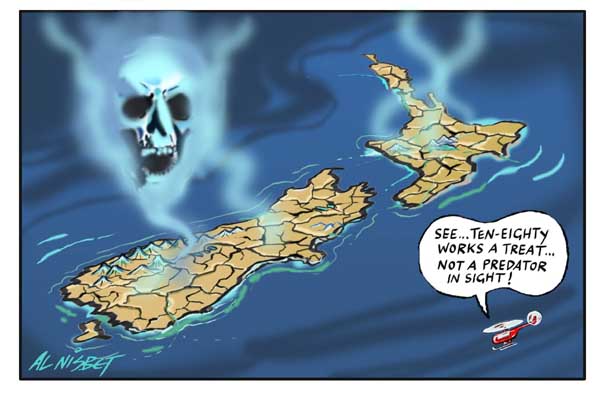
Above Map by well known NZ cartoonist - Al Nesbit
April 20th from FB No to 1080 use
"WILL NEW ZEALAND'S DEPT OF CONSERVATION WIN AGAINST RODENTS AND STOATS WITH 1080 POISON ?"
Below art from:Samantha Cox Reilly for this beautiful piece of art work.
from FB: Wendy Mitchell May5th 2019

A deer riddled with tumors from eating plants sprayed with Monsanto's Roundup now Bayer. It seems fairly common. Link on FB 2117
see more on https://www.wideopenspaces.com/whitetailwednesday-8-of...

Some simple facts about 1080 poison below.
Credit: PredatorDefense.org

CHECK & PLEASE SUPPORT BAN ON 1080-: they need your support & comments
https://www.facebook.com/ban1080party/
Carol Sawyer FB
May 28 at 11:13 AM
UPCOMING AERIAL 1080 DROP, LUGGATE -
UNJUSTIFIABLE AND VERY DANGEROUS TO COMMUNITY -
AN AG-PILOT SPEAKS OUT ON DUST CONTAMINATION:
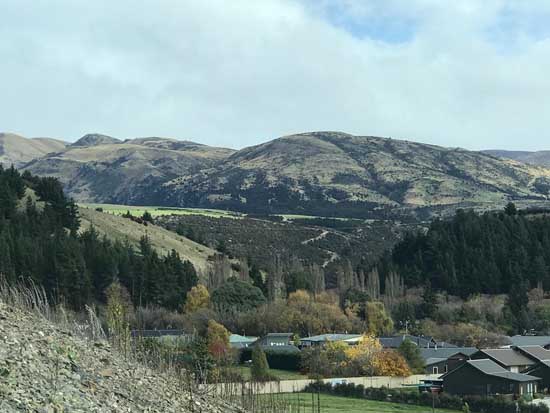
Photos of Luggate: Tracey Morrow
The immediate threat to Luggate township,[pic above] (near Wanaka, Central Otago), is that the prevailing wind at this time of year comes straight down the valley to Luggate. See ag-pilot John Sarginson's testimony here:
"'The Pisa range to the Southwest of Luggate is known to generate Katabatic winds (downhill winds). Katabatic winds are very common on calm wind days typical of the days we have in Autumn, Winter and Spring, hence fog in the lower catchments. These winds start from high on the Pisa range and start flowing down the hillsides, gaining speed as the night approaches. They flow with strength well into the small hours of the night. Hence there is often no fog in these areas in the evenings.
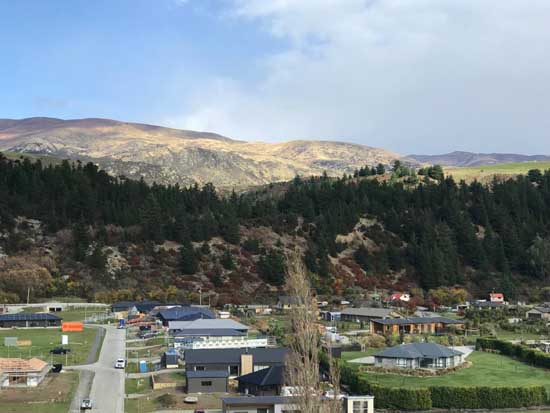
Photos of Luggate: Tracey Morrow
It is very common for places like Luggate and Queensberry to experience long periods (> 10 hours) of quite strong Katabatic winds, say > than 15 knots (30 km/h) late evenings. The Katabatic winds are strongest when channelled by valleys. Luggate has four main valley systems that line these winds up for the Luggate township. The four valleys are Luggate Creek, Alice Burn, Tin Hut, and Dead Horse Creek. All four valley katabatic wind systems converge on the township of Luggate.
|

Photos of Luggate: Tracey Morrow
As a former accredited agricultural pilot with more than 6000 hours of flight time I would consider dispensing 1080 in the hills to the south of Luggate during these times of the year to be a very high risk to all. The baits may fall in no wind, but when the wind increases, maybe days later, some baits will fall further in scrub and others are blown across exposed areas causing toxic dust to become airborne again. Sublethal amounts of a harmful poison would be distributed onto roofs that collect drinking water and onto gardens that grow food.
No one can guarantee such drift of 1080 dust will not cause future health risks to our generation, or to generations of the future.
No one can guarantee that people won’t suffer increased illnesses or deficiencies.
No one can guarantee that people's lives will not be shortened by 1080 toxic dust.
And worse still, no one can claim to detect acute 1080 poisoning in all instances, and sublethal poisoning is almost impossible to detect.
My past work has involved the application of many chemicals onto our land, including 1080 poison, and I still have a vested interest in aerial ag operations and wish to protect it. It is my view from the knowledge I have gained in industry, that sublethal 1080 poisoning is a very real and dangerous risk that should be avoided. Effects from sublethal 1080 poisoning can’t be detected or traced, symptoms mirror other serious illnesses, there is no known antidote, and again no one knows the extent of its real dangers.
John Sarginson, Thornbury, Southland, 28 May, 2019
************************************
Statements from the Environmental Risk Management Authority ( ERMA ) Review ( 2007 ) outlined the threat from toxic 1080 dust . See note 2 at end.
Also the NZ Journal of Ag Research has an interesting article on dust contamination. See note 3 at end.
A scoping study was done by the Institute for Environmental Science and Research ( ESR ) which mentions the possibility of dust inhalation and dust deposition on food and crops and in drinking water. See note 4 at end.
*************************************
NO TB IN WILDLIFE:
In mid-May, 2019, I spoke to Eric Chagnon, operations manager OSPRI, Dunedin, who told me there has been no change in their information/justifications for the drop since last year. In other words the status quo remains the same as it was in June, 2018. Here are the findings at that time, as revealed in a response to an OIA request by Alan Galletly:
OSPRI’s findings:
260 possums tested – NONE with TB
130 ferrets tested ONE with TB in 2012
6 feral pigs tested – NONE with TB
See complete OIA response below. Note 1.
*************************************
THAT 2012 FERRET:
When Mt Roy, Wanaka, was due to be aerially 1080-poisoned, in early 2015, one of the justifications for it, received via OIA request, was that same ferret found at Luggate, 20 km away, in 2012.
Mt Roy never happened. The Alice Burn East drop at Luggate should not be happening either!
**************************************
WATERWAYS:
This drop is less than 1 km from the nearest homes in Luggate Village and the baits will be going directly into the Alice Burn and Luggate Creek, which flows through Luggate Village and through the Luggate Campground. Poisoned carcasses will also end up in the two waterways. ( Both the end of Atkins Rd and end of Kingan Rd, including the Camp Ground, are less than 1km away from the drop boundary.)
***************************************
ACCESSIBILITY:
The land is NOT inaccessible for trapping... see photo... and this is borne out by the fact they trapped possums there for TB testing! There is no need to arerially and indiscriminately drop poison from helicopters onto this land. See photos.
*********************************************************
END NOTES:
Note 1: Alan Galletly’s OIA request and OSPRI responses... 2018
Question: How close to the drop zone is the nearest infected herd?
Answer: Adjacent to the aerial control
******************
Q :What monitoring of possums has been done in the drop zone? If so when was this done?
A: None
******************
Not guilty!
Q : Have possums been caught in the drop zone. If so when
A: Yes: 2009, 2010, 2012, 2013, 2016
******************
Q: Were any possums tested for TB from the drop zone? What number were tested for TB? What was the results of those tests?
A: Yes: 260 tested , 0 positive for TB
******************
Q: Have any ferrets been caught in the drop zone ? If so when.
A: Yes: 2010, 2012, 2013, 2015, 2016, 2018
******************
Q: Were any ferrets tested for TB from the drop zone? What number were tested for TB? What was the results of those tests?
A: Yes: 130: 1 positive for TB (2012)
*******************
Q: Have any feral pigs been caught in the drop zone? If so when?
A: Yes: 2014 and 2015
*******************
Q: Were any feral pigs tested for TB from the drop zone? What number of feral pigs were tested for TB? What were the results of those tests?
A: Yes; 6 tested; 0 positive for TB
******************
Q: What percentage of the drop zone is Department Of Conservation estate. What is the total hectares of DOC estate in the drop zone if any?
A: Out of total consented area of 1,973 hectares:
292 ha DOC
1,681 ha private land
****************
Q: Spending taxpayers money to solve a non-existent problem – bovine TB
What is the total OSPRI budget for the Luggate aerial drop and is it expected to exceed that budget ?
A: The Alice Burn East Aerial is not expected to exceed the budgeted amount of $194,640
****************
Q: How close to the drop zone is the nearest infected herd?
A: Adjacent to the aerial control
*****************
Q: Finally I must remind you of your obligation to consult with the local community. To date you have failed dismally and the behaviour of OSPRI staff at the Wanaka event can best be described as childish and completely unacceptable for such an government appointed organization. You are obliged to address public concerns and you have failed to do so to date. I ask when are you going to do this in a public forum?
A: OSPRI considers that all statutory obligations for the operations concerned have been met. No further public forum is planned
*****************************************************************
Note 2: DUST
Statements from the Environmental Risk Management Authority ( ERMA ) Review ( 2007 ).
475 5 Agency App. E “The main conclusion that can be drawn..is that dust drift can occur over a considerable distance off-site (at least 1 km)”
475 3 Agency App. E “Three aerial operations using cereal baits were monitored for dust drift in 1997 and 1998..The maximum deposition of 1080 falling in dust [from cereal bait] was 25.2 μg/m²..residues in dust inside all treatment areas were significantly greater than outside at day 1, but not at day 5”
477 1 Agency App. E “[1080 concentration in dust, μg/m², inside treatment area] Day 1 3.81 , Day 5 0.1..outside treatment area (day 1) 0.2 at 200m, 0.06 at 1 km”
475 6 Agency App. E “The Agency is not aware of any other studies reporting on dust drift from aerial application of 1080..there is insufficient information to know whether other bait types or delivery buckets would create more or less dust”
476 2 Agency App. E “Trace levels (of 1080) were found in 11 plant samples [after 1080 cereal operations at Whitecliffs and Titirangi]..the maximum measured was 0.014 mg/kg..on day 1..it is unknown whether the residues in plants resulted from dust deposition or uptake from the soil, the authors attributed them to dust.”
13 1 Submitter 9143 “Observation on the day of the poison operation showed that the fine particles and dust were blown across the forest canopy from the helicopter bait bucket” (Meads report)
3 2 Submitter 9143 “181 mm of rain fell in the second fortnight after the poison operation. Thus an influx of 1080 may have washed from the tree tops to the ground” (Meads Report)
Note 3: DUST CONTAMINATION
"The risk of drift of 1080 dust:
While the 1080 concentration found in the bait dust
was much greater inside than outside the treatment
areas, results were less clear for the soil, leaf litter,
and plant samples. In some of these cases, similar
concentrations of 1080 were found outside as inside
the treatment areas. These results indicate that bait
dust can drift outside the boundaries of a treated
area up to and possibly more than 1000 m. " |
https://www.researchgate.net/…/links/55f8853708ae07629dd826…
Note 4: SCOPING STUDY
Study by the Institute for Environmental Science and Research ( ESR ):
"Dust drift may potentially arise from aerial application of 1080. This is because physical abrasion from transport, loading and aerial application of 1080 bait can generate dust particles that could drift over loading zone and application zone boundaries. Some of these particles could deposit on food or crops, or in water tanks used for drinking water. Other particles may be sufficiently fine to travel significant distances and be inhaled by people."
In the end, I am told by a researcher, the study ".... was flawed though. For example control sample got contaminated (again) and they ‘couldn’t get hold of the distilled water for the collection points’. Not sure why as distilled water is widely available isn’t it!?! "
https://www.esr.cri.nz/…/FW15060-1080-dust-report-FINAL-web…
LIKE MANY ORGS THERE ARE GOOD AND BAD BUT BE VERY WEARY DONATING TO SOME ORGANIZATIONS THAT PRETEND TO BE FOR CHANGING THE WORLD WHICH TODAY IS NEAR IMPOSSIBLE. However there are very good organisations with a track record of helping wild life and birds in this world. They need the support as the survival of humans is looked at thru the eyes of the creatures on this earth who have a place. Share |
|


















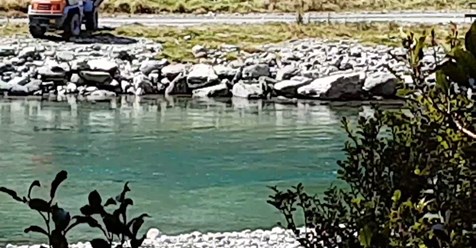





























 Email us:
Email us: